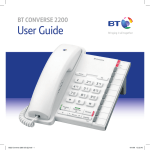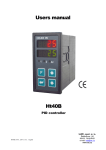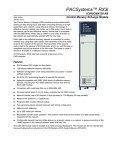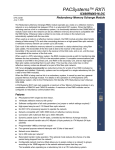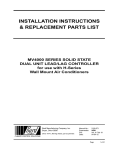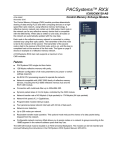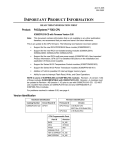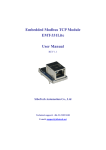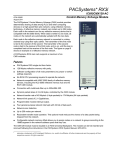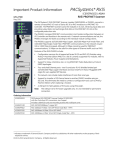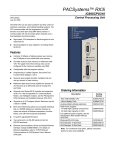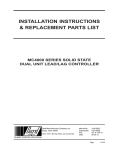Download PACSystems Memory Xchange Modules Users` Manual
Transcript
GE Intelligent Platforms Programmable Control Products PACSystems* Memory Xchange Modules User’s Manual, GFK-2300D March 2010 GFL-002 Warnings, Cautions, and Notes as Used in this Publication Warning Warning notices are used in this publication to emphasize that hazardous voltages, currents, temperatures, or other conditions that could cause personal injury exist in this equipment or may be associated with its use. In situations where inattention could cause either personal injury or damage to equipment, a Warning notice is used. Caution Caution notices are used where equipment might be damaged if care is not taken. Note: Notes merely call attention to information that is especially significant to understanding and operating the equipment. This document is based on information available at the time of its publication. While efforts have been made to be accurate, the information contained herein does not purport to cover all details or variations in hardware or software, nor to provide for every possible contingency in connection with installation, operation, or maintenance. Features may be described herein which are not present in all hardware and software systems. GE Intelligent Platforms assumes no obligation of notice to holders of this document with respect to changes subsequently made. GE Intelligent Platforms makes no representation or warranty, expressed, implied, or statutory with respect to, and assumes no responsibility for the accuracy, completeness, sufficiency, or usefulness of the information contained herein. No warranties of merchantability or fitness for purpose shall apply. * indicates a trademark of GE Intelligent Platforms, Inc. and/or its affiliates. All other trademarks are the property of their respective owners. ©Copyright 2010 GE Intelligent Platforms, Inc. All Rights Reserved Contact Information If you purchased this product through an Authorized Channel Partner, please contact the seller directly. General Contact Information Online technical support and GlobalCare http://www.ge-ip.com/support 1H2 Additional information http://www.ge-ip.com/ 3H Solution Provider [email protected] 4H Technical Support If you have technical problems that cannot be resolved with the information in this guide, please contact us by telephone or email, or on the web at www.ge-ip.com/support 5H Americas Online Technical Support www.ge-ip.com/support 6H7 Phone 1-800-433-2682 International Americas Direct Dial 1-780-420-2010 (if toll free 800 option is unavailable) Technical Support Email [email protected] 8H9 Customer Care Email Primary language of support [email protected] 10H English Europe, the Middle East, and Africa Online Technical Support www.ge-ip.com/support 12H3 Phone +800-1-433-2682 EMEA Direct Dial +352-26-722-780 (if toll free 800 option is unavailable or if dialing from a mobile telephone) Technical Support Email [email protected] 14H5 Customer Care Email Primary languages of support [email protected] 16H7 English, French, German, Italian, Czech, Spanish Asia Pacific Online Technical Support www.ge-ip.com/support Phone 18H9 +86-400-820-8208 +86-21-3217-4826 (India, Indonesia, and Pakistan) Technical Support Email [email protected] (China) 20H1 [email protected] (Japan) 2H3 [email protected] (remaining Asia customers) 24H5 Customer Care Email [email protected] 26H7 [email protected] (China) 28H Contents Introduction....................................................................................................................1-1 Overview ........................................................................................................................... 1-2 Basic Memory Xchange Operation .......................................................................... 1-2 Sample Memory Xchange Network ......................................................................... 1-3 Memory Xchange Features .............................................................................................. 1-4 RX3i Reflective Memory Module Features .............................................................. 1-4 IC695CMX128 and IC695RMX128 Functional Compatibility .................................. 1-5 RX7i Reflective Memory Module Features .............................................................. 1-6 IC698CMX016 and IC698RMX016 Functional Compatibility .................................. 1-7 Reflective Memory Hub............................................................................................ 1-7 QuickStart ......................................................................................................................2-1 Installation and Configuration......................................................................................3-1 RX3i Memory Xchange Module User Features ................................................................ 3-2 CMX128 LEDs ......................................................................................................... 3-2 RMX128 LEDs ......................................................................................................... 3-3 Optical Transceiver .................................................................................................. 3-3 RX7i Memory Xchange Module User Features ................................................................ 3-4 Role Switch (RMX Only) .......................................................................................... 3-5 Node ID .................................................................................................................... 3-5 Redundant Transfer Mode Operation ...................................................................... 3-5 Network Memory Offset ........................................................................................... 3-6 Rogue Packet Detection and Removal .................................................................... 3-7 Physical Installation .......................................................................................................... 3-8 RX3i Memory Xchange Modules ............................................................................. 3-8 RX7i Memory Xchange Modules ............................................................................. 3-9 Network Connection........................................................................................................ 3-10 VMICBL-000-F5-0xx Cable Lengths ...................................................................... 3-10 Fiber-optic Connectors........................................................................................... 3-10 Fiber-optic Cables .................................................................................................. 3-11 Hardware Configuration.................................................................................................. 3-12 Configuring a Memory Xchange Module................................................................ 3-12 Configuration Parameters ...................................................................................... 3-13 Basic Operation .............................................................................................................4-1 Powerup and Initialization................................................................................................. 4-1 BUS_ Functions ................................................................................................................ 4-2 Multiple Writes to Network Memory .................................................................................. 4-4 Data Transfer Time ........................................................................................................... 4-5 RX3i Read/Write Transfer Times ............................................................................. 4-5 RX7i Read/Write Transfer Times ............................................................................. 4-5 Estimating Total Transfer Time ................................................................................ 4-6 Special Considerations for Stores of Configuration.......................................................... 4-7 GFK-2300D v Contents Advanced Operation .....................................................................................................5-1 Module Interrupts .............................................................................................................. 5-2 Interrupt Initialization Logic ...................................................................................... 5-4 Interrupt Handling Logic ........................................................................................... 5-5 Associating Module Interrupts with Logic................................................................. 5-6 Dynamic Masking of Module Interrupts.................................................................... 5-6 Network Interrupts............................................................................................................. 5-8 Sending Network Interrupts...................................................................................... 5-8 Receiving Network Interrupts ................................................................................... 5-8 Memory Parity Checking................................................................................................. 5-11 On-demand Memory Clear ............................................................................................. 5-13 Checking Ring Integrity................................................................................................... 5-13 Optimizing Network Bandwidth....................................................................................... 5-14 Using Network Interrupts to Balance Network Load .............................................. 5-14 Memory Xchange Module Specifications................................................................... A-1 Register Definitions...................................................................................................... B-1 Region 2: Primary Control and Status Registers.............................................................. B-2 Local Control and Status Register (LCSR) .............................................................. B-3 Local Interrupt Status Register (LISR) ..................................................................... B-5 Local Interrupts Enable Register (LIER) .................................................................. B-7 Registers for Generating Network Interrupts ........................................................... B-8 Registers for Receiving Network Interrupts ............................................................. B-9 Region3: Auxiliary Control and Status Registers............................................................ B-11 Offset 440h............................................................................................................. B-11 Offset 441h............................................................................................................. B-11 Offset 442h............................................................................................................. B-12 Offset 445h............................................................................................................. B-12 Offset 446h............................................................................................................. B-12 Region 4: Interrupt Acknowledge Register ..................................................................... B-13 Interrupt Acknowledge Register (IAKR) ................................................................. B-13 vi PACSystems™ Memory Xchange Modules User’s Manual–March 2009 GFK-2300D Chapter Introduction 1 This manual describes the features, installation, and operation of the following Memory Xchange modules in a PACSystems reflective memory network: IC695CMX128 IC695RMX128 IC698CMX016 IC698RMX016 RX3i Control Memory Xchange (CMX) module RX3i Redundancy Memory Xchange (RMX) module RX7i Control Memory Xchange (CMX) module RX7i Redundancy Memory Xchange (RMX) module This chapter presents an overview of Memory Xchange operation (page 1-2), and a summary of Memory Xchange features and functional compatibility (page 1-4). For additional information, refer to the following chapters: ■ Chapter 2, “QuickStart” – Provides an overview of the steps needed to configure and operate a reflective memory network and to verify Memory Xchange operation. ■ Chapter 3, “Installation and Configuration” – describes user features, and provides procedures for physical installation and software configuration. ■ Chapter 4, “Basic Operation” – describes the operation of basic Memory Xchange module functions and how to access them. ■ Chapter 5, “Advanced Operation” – describes how to use the advanced capabilities of the Memory Xchange module ■ Appendix A, “Memory Xchange Module Specifications” – provides performance and environmental specifications. ■ Appendix B, “Register Definitions” – provides detailed definitions of the module’s registers. Related Publications PACSystems CPU Reference Manual, GFK-2222 PACSystems RX7i Installation Manual, GFK-2223 PACSystems RX3i System Manual, GFK-2314 PACSystems RX7i User's Guide to Integration of VME Modules, GFK-2235 PACSystems Hot Standby CPU Redundancy User’s Manual, GFK-2308 Proficy Machine Edition Logic Developer Getting Started, GFK-1918 For the most recent versions of PACSystems and related documentation, visit the GE website: http://www.ge-ip.com/ GFK-2300D 1-1 1 Overview The Memory Xchange modules use reflective memory technology, which allows the deterministic sharing of data among Controllers and other computing devices on a high-speed fiber optic network. Deterministic networks enable sharing of data within a predetermined time interval. The network can be made up of any combination of these modules and other reflective memory devices that are network compatible with the GE Embedded Systems 5565 family. Each such device is a node on the network. A reflective memory network can contain up to 256 nodes. Whenever data is written to one node, all nodes on the network are automatically updated with the new data. Each node in the reflective memory network is connected in a daisy-chained loop using fiber-optic cables. The transmitter of the first node is tied to the receiver of the second. The transmitter of the second node is tied to the receiver of the third node, and so on, until the loop is completed back at the receiver of the first node. The figure on page 1-5 shows an example of a seven-node reflective memory network. The RMX modules can be used in a redundant system (two CPUs), as part of a redundancy link. A complete redundancy link consists of one RMX in the primary unit, one RMX in the secondary unit, and high-speed fiber optic cables connecting them to each other. This must be a two-node ring: no other reflective memory nodes are allowed to be part of this fiber optic network. When the RMX is being used as redundancy link, it cannot be used as a general-purpose Memory Xchange module. When the RMX is not being used as a redundancy link, it is functionally identical to the CMX module. For details on the operation of a PACSystems Hot Standby CPU redundancy system, refer to the PACSystems Hot Standby CPU Redundancy User’s Manual, GFK-2308. Basic Memory Xchange Operation After the module has been configured, a transfer of data over the network can be initiated by writing to the reflective memory region through the backplane bus. The Memory Xchange module forms the data into variable length packets sized from 4 to 64 bytes, which it transmits over the fiber-optic network to the receiver of the next node. Whenever a packet is received, the Memory Xchange module evaluates the packet. If the packet is valid and did not originate on this node, it is accepted. If, however, the data packet is invalid or if it originated at this node, it is discarded. The receiving node writes the data into the local reflective memory and simultaneously transmits the data to the next node on the network. From there, the process is repeated until the data returns to the originating node, where it is removed from the network. Basic operating functions are configured using Proficy™ Machine Edition Logic Developer. 1-2 PACSystems™ Memory Xchange Modules User’s Manual – March 2009 GFK-2300D 1 Sample Memory Xchange Network CMX PCI WorkStation with VMIPCI-5565 reflective memory board CMX CMX CMX GFK-2300D Chapter 1 Introduction 1-3 1 Memory Xchange Features RX3i Reflective Memory Module Features A PACSystems RX3i main rack supports a maximum of six Memory Xchange modules. 1-4 ■ PACSystems RX3i single slot form factor. ■ 128 Mbytes reflective memory with parity. ■ Software configuration of all node parameters (no jumper or switch settings required). ■ No RX3i CPU processing required to operate the network. ■ Network-compatible with the GE Embedded Systems 5565 family of reflective memory devices. ■ Connection with multimode fiber up to 1000 ft. or 304.80m. ■ Dynamic packet sizes of 4 to 64 bytes, controlled by the CMX module. ■ Network transfer rate of 43 Mbyte/s (4 byte packets) to 174 Mbyte/s (64 byte packets) ■ Network link speed of 2.1 Gbits/s ■ Programmable module interrupt. ■ Four general-purpose network interrupts with 32 bits of data each. ■ Network error detection. ■ Up to 256 nodes per network. OK OK CONFIG LINK OK SIG DETECT SIG DETECT OWN DATA OWN DATA CMX128 RMX128 NODE 1 ROLE SWITCH 0 LOCAL READY ACTIVE REMOTE ■ Redundant transfer mode operation. This optional mode reduces the chance of a data packet being dropped from the network. ■ Configurable network memory offset for compatibility with RX7i Memory Xchange applications. READY ACTIVE NODE TX (FRONT) TX (FRONT) RX (BACK) RX (BACK) PACSystems™ Memory Xchange Modules User’s Manual – March 2009 GFK-2300D 1 IC695CMX128 and IC695RMX128 Functional Compatibility GFK-2300D ■ PACSystems RX3i CPU with firmware version 5.50 or later for CMX128 and PACSystems RX3i CPU with firmware version 5.70 or later for RMX128. ■ Programming software: Proficy Machine Edition Logic Developer, version 5.8 or later for CMX128 and Proficy Machine Edition Logic Developer, version 5.9 SIM1 or later for RMX128. ■ Only the RMX can operate as a redundancy link. Redundancy link operation requires a CPU that supports CPU redundancy, such as the IC695CRU320 (firmware version 5.70 or later) and Proficy Machine Edition Logic Developer version 5.90 SIM1 or later. ■ Compatible with reflective memory devices in the GE Embedded Systems 5565 family. The PACSystems Memory Xchange module does not operate with other reflective memory families offered by GE Embedded Systems. Chapter 1 Introduction 1-5 1 RX7i Reflective Memory Module Features An RX7i main rack supports a maximum of four Memory Xchange modules in any combination of RMX and CMX modules. When using CPU redundancy, up to two RMX modules in a rack can be configured as redundancy links. CMX016 ■ PACSystems single slot form factor. ■ 16 Mbytes reflective memory with parity. ■ Software configuration of all node parameters (no jumper or switch settings required). ■ No PACS CPU processing required to operate the network. ■ Network-compatible with the GE Embedded Systems 5565 family of reflective memory devices. ■ Connection with multimode fiber up to 1000 ft. (304.80m). ■ Dynamic packet sizes of 4 to 64 bytes, controlled by the Memory Xchange module. RMX016 OK OK LINK OK CONFIG LOCAL 1-6 READY ACTIVE REMOTE READY ACTIVE ROLE SWITCH 1 0 ■ Network transfer rate of 43 Mbyte/s (4 byte packets) to 174 Mbyte/s (64 byte packets) ■ Network link speed of 2.1 Gbits/s ■ Programmable VMEbus interrupt output. ■ Four general-purpose network interrupts with 32 bits of data each. ■ Network error detection. OWN DATA OWN DATA ■ Up to 256 nodes per network. SIGNAL DETECT SIGNAL DETECT ■ Redundant transfer mode operation. This optional mode reduces the chance of a data packet being dropped from the network. TX TX RX RX ■ Configurable network memory offset allows you to assign nodes on a network to groups according to the 16MB segment in the network address space that they use. IC698CMX016 IC698RMX016 PACSystems™ Memory Xchange Modules User’s Manual – March 2009 GFK-2300D 1 IC698CMX016 and IC698RMX016 Functional Compatibility ■ PACSystems RX7i CPU with firmware version 2.0 or later. ■ Only an RMX can operate as a redundancy link. To operation as a redundancy link, RMX modules require a CPU that supports CPU redundancy, such as the IC698CRE020. ■ Programming software: Proficy Machine Edition Logic Developer, version 4.5 or later ■ When used as a general-purpose reflective memory module, the RX7i Memory Xchange modules are compatible with reflective memory devices in the GE Embedded Systems 5565 family. The PACSystems Memory Xchange module does not operate with other reflective memory families offered by GE Embedded Systems. Reflective Memory Hub The VMIACC-5595 is a managed hub designed to operate with the GE 5565 family of Reflective Memory real-time network products. The Reflective Memory hub can automatically bypass ports when it detects a loss of signal or the loss of valid synchronization patterns, allowing the other nodes in the network to remain operational. For additional information, refer to the VMIACC-5595 2Gb/s Reflective Memory Hub Installation Guide, 522-805595-000, which is available at http://www.ge-ip.com/support. GFK-2300D Chapter 1 Introduction 1-7 Chapter QuickStart 2 This chapter provides an overview of the steps needed to configure and operate a basic reflective memory network and to verify Memory Xchange operation. Note: For operation of an RMX in a redundancy system, refer to the PACSystems Hot Standby CPU Redundancy User’s Manual, GFK-2308. Performance Recommendations To transfer data most efficiently, use the minimum number of reads/writes possible. For example, use one long read/write instead of several. Length is specified in data size (DWORDS). For maximum performance, Offset, which is specified in BYTES, should be specified in numbers divisible by 4, so that bus accesses are DWORD aligned. 1. Install the Memory Xchange module in the rack system. If necessary, apply power to the controller. When power is applied to the module an internal loopback test occurs; the OWN DATA and SIGNAL DETECT indicators turn on briefly during this test. When the Memory Xchange module and the CPU are powered up and functioning properly, the module’s OK indicator is on. Warning RX7i modules do not support hot installation and removal. Do not insert or remove RX7i modules with power applied. This could cause the CPU to stop, damage the module, or result in personal injury. Note: RX3i Memory Xchange modules support hot insertion and removal. For installation details, refer to “Physical Installation” in chapter 3. 2. Using the Logic Developer software, add the Memory Xchange module to the rack configuration. GFK-2300D 2-1 2 3. Connect the module to the network. Using an LC- compatible multimode fiber optic cable, connect the module’s TX connector to the RX connector of the next module in the ring. Connect the fiber optic cable from that module’s TX to the RX connector of the next module. Repeat this step until the last node in the ring routes its TX to the RX of the first node. For cable details, see “Network Connection” in Chapter 3. When the fiber optic transceiver detects a signal on the network, the SIGNAL DETECT indicator will be on. TX TX TX RX RX RX 4. Configure the module’s operating parameters and download the configuration to the controller. Each Memory Xchange module on the network must have a unique Node ID. If the network contains more than one Memory Xchange module, change the Node ID. For details on configuring other parameters, see “Hardware Configuration” in chapter 3. When the module receives a configuration, it sends a test packet to determine whether all nodes on the ring are connected with transmitters enabled. If all nodes are configured correctly and powered on, the OWN DATA indicator should be on, indicating the module has received its own data packet from the network at least once. When the module is configured, its CONFIG or LINK OK indicator is on. 2-2 PACSystems™ Memory Xchange Modules User’s Manual – March 2009 GFK-2300D 2 5. Use a BUS_WRT_DWORD function to write data to the network. Do not inadvertently overwrite data from another node. To detect whether the write operation succeeded or failed, record the value of the ST (status) output and note whether the BUS_WRT function passed power. For example, if the module is not in the rack or if an incorrect slot number is used as an input to the function, the BUS_WRT operation will not succeed. If the bus write operation is successful, the BUS_WRT function will pass power and the ST output will have a value of 0. In the following example, the inputs R, S, RGN and OFF indicate the data is being written to a module located in Rack 0, Slot 5, Region 1 and Offset 16. For details on the use of BUS_WRT and BUS_RD functions, refer to “BUS_ Functions” in Chapter 4. BUS_WRT_DWORD Function Details Parameter ?? Definition Length. Specifies the number of DWORDs to write. Inputs IN Starting address of the data to write. Must be a DWORD variable. R Rack location of module. For a Memory Xchange module, must be 0 (Main rack). S Slot location of module. SS Subslot (always 0) RGN Region in module user memory to write to. Region 1 corresponds to the module’s reflective memory. OFF BYTE offset of starting address to be written to within the memory region. This is a 0-based address. Note that Offset is specified in BYTEs regardless of the type of BUS_ function being used. For maximum performance, Offset should be specified in numbers divisible by 4, so that bus access is DWORD aligned. Output ST GFK-2300D Status word for the write operation. Chapter 2 QuickStart 2-3 2 6. Use a BUS_RD_DWORD function to read data from the network. If the bus read operation is successful, the ST output will have a value of 0. If the Bus_RD function passes power, the data requested is present and valid. If the Bus_RD function does not pass power, the data may be in an indeterminate state – for example if loss of module occurred during read. Check the ST (status) output to determine the cause of failure. The DWORD value returned in the output Q should be the same as the value written in step 4. In the following example, the inputs R, S, RGN and OFF indicate the data is being read from a module located in Rack 0, Slot 5, Region 1 and Offset 16. BUS_RD_DWORD Function Details Parameter ?? Definition Length. Specifies the number of DWORDs to read. Inputs R Rack location of module. For a Memory Xchange module, must be 0 (Main rack). S Slot location of module. SS Subslot (always 0) RGN Region in module user memory to read from. Region 1 corresponds to the module’s reflective memory. OFF BYTE offset of starting address to be read from within the memory region. This is a 0-based address. Note that Offset is specified in BYTEs regardless of the type of BUS_ function being used. For maximum performance, Offset should be specified in numbers divisible by 4, so that bus access is DWORD aligned. Outputs 2-4 ST Status word for the read operation. Q Starting address where the data is to be placed. Must be a DWORD variable. PACSystems™ Memory Xchange Modules User’s Manual – March 2009 GFK-2300D Chapter Installation and Configuration 3 This chapter provides a guide to the user features, physical installation, and initial configuration of the Memory Xchange module. Before you can use the Memory Xchange module, you must configure it using Proficy Machine Edition Logic Developer software. The programming software allows you to specify a basic hardware configuration for the Memory Xchange module that allows it to operate in a reflective memory network or as a redundancy link (RMX modules only). GFK-2300D 3-1 3 RX3i Memory Xchange Module User Features CMX128 LEDs LED Label Description OK OK ON indicates the module and the CPU are functioning properly. CONFIG* ON indicates the module is configured. SIG DETECT ON indicates the receiver is detecting a fiber optic signal. OWN DATA ON indicates the module has received its own data packet from the network at least once. CONFIG SIG DETECT OWN DATA CMX128 NODE * A reflective memory hub can be used to bypass a node that is not configured. Optical Transceiver (bottom view) TX TX (FRONT) RX (BACK) RX 3-2 PACSystems™ Memory Xchange Modules User’s Manual – March 2009 GFK-2300D 3 RMX128 LEDs LED Label OK LINK OK Description OK ON indicates the module is functioning properly. LINK OK SIG DETECT OWN DATA When used as a redundancy link, ON indicates the link is functioning properly. When not used as a redundancy link, ON indicates the module is configured. SIG DETECT ON indicates the receiver is detecting a fiber optic signal. OWN DATA ON indicates the module has received its own data packet from the network at least once. LOCAL READY ON indicates the local unit is ready. LOCAL ACTIVE ON indicates the local unit is active. REMOTE READY ON indicates the remote unit is ready. REMOTE ACTIVE ON indicates the remote unit is active. RMX128 1 ROLE SWITCH 0 LOCAL READY ACTIVE REMOTE Optical Transceiver (bottom view) TX READY ACTIVE NODE TX (FRONT) RX (BACK) RX Optical Transceiver The optical transceiver, which is located on the bottom of the module, has two “LC” type fiber optic ports. The port labeled “TX” is the transmitter and the port labeled “RX” is the receiver. CMX modules are networked together using either simplex (single fiber) or duplex (dual fiber) multimode fiber optic cables. The specific cable construction depends on your operating environment. For details on cables, see “Fiber Optic Cables and Connectors” on page 3-10. GFK-2300D Chapter 3 Installation and Configuration 3-3 3 RX7i Memory Xchange Module User Features CMX016 LEDs The general purpose RX7i CMX module has four LEDs and an optical transceiver. LED Label CMX016 RMX016 Description OK ON indicates the module and CPU are functioning properly. CONFIG* Indicates the module is configured. OWN DATA ON indicates the module has received its own data packet from the network at least once. SIGNAL DETECT OK OK LINK OK CONFIG LOCAL READY ACTIVE ON indicates the receiver is detecting a fiber optic signal. * A reflective memory hub can be used to bypass a node that is not configured. REMOTE READY ACTIVE RMX016 LEDs The RX7i RMX module has eight LEDs, a role switch and an optical transceiver. LED Label Description OK ON indicates the module and CPU are functioning properly. LINK OK When not used as a redundancy link, ON indicates the module is configured. When used as a redundancy link, ON indicates the link is functioning properly. LOCAL READY ON indicates the local unit is ready. ROLE SWITCH 1 0 LOCAL ACTIVE ON indicates the local unit is active. REMOTE READY ON indicates the remote unit is ready. REMOTE ACTIVE ON indicates the remote unit is active. OWN DATA ON indicates the module has received its own data packet from the network at least once. SIGNAL DETECT ON indicates the receiver is detecting a fiber optic signal. Optical Transceiver OWN DATA OWN DATA SIGNAL DETECT SIGNAL DETECT TX TX RX RX IC698CMX016 IC698RMX016 The optical transceiver has two “LC” type fiber optic ports. The port labeled “TX” is the transmitter and the port labeled “RX” is the receiver. For details on cables, see “Fiber Optic Cables and Connectors” on page 3-10. 3-4 PACSystems™ Memory Xchange Modules User’s Manual – March 2009 GFK-2300D 3 Role Switch (RMX Only) The Role switch is a spring-loaded two-position switch that rests in the OFF state. When the RMX module is being used as a redundancy link, this switch allows you to manually switch control from the active controller to the backup controller. To initiate the switching of roles, lift the switch to the ON position for at least 1 second. The role switch state is de-bounced and filtered to prevent accidental activation. When the RMX module is used as a node in a general-purpose reflective memory network (i.e. not used as a redundancy link), the Role switch has no effect on module operation. Node ID Each node in a reflective memory network must have a unique Node ID, which may range from 0 through 255. Node ID is configured by the programming software. Redundant Transfer Mode Operation Redundant Transfer mode is enabled or disabled using hardware configuration in the programming software. While in the Redundant Transfer mode, each packet is transferred on the network twice. The receiving node evaluates each redundant transfer. If no errors are detected in the first transfer, it is used to update the onboard memory and the second transfer is discarded. If the first transfer contains an error, the second transfer is used to update the on-board memory provided it has no transmission error. If errors are detected in both transfers, neither transfer is used and the data is completely removed from the network. The Bad Data bit (Bit 01 of the LCSR in Region 2) is set if an error is detected in either transfer. Redundant Transfer mode greatly reduces the chance that data is dropped from the network. However, the redundant transfer mode reduces the effective network transfer rates by approximately 50 percent. Note: GFK-2300D The Redundant Transfer mode pertains only to the method of transferring packets over the network. It does not relate to redundancy link operation nor does it relate to the Redundancy LEDs. Chapter 3 Installation and Configuration 3-5 3 Network Memory Offset For a given node, an offset can be added to the addresses of network packets initiated by local bus writes to the Memory Xchange module. This offset is also subtracted from incoming network packets before applying them to the local reflective memory. The network memory offset is configured in the programming software. The offset can be from 0 to 240 MB, in increments of 16 MB. The Network Memory Offset is configured by the programming software. This feature allows you to assign nodes on a network to groups according to the 16MB segment in the network address space that they use. The nodes that use the same offset in the network address space effectively behave as if they are in their own network. The figure below provides an example of a six-node network that has two groups of nodes. Nodes 1—3 use the first 16 MB in the network address space (offset 0); nodes 4—6 use the second 16MB of the network address space (offset 16MB). For an RX3i CMX128 module, if the sum of the address and offset exceeds the 256 Mbyte network address range, the address bits beyond 256 Mbyte will be truncated. This causes the write to wrap around into a lower memory location. Network with Node Groups Assigned to Two Network Address Space Ranges Network Address Space Offset 240 MB 1 Nodes 1—3 have offset 0 6 Nodes 4—6 have offset 16 2 224 MB 5 80 MB 64 MB 3 4 48 MB 32 MB 16 MB 0 MB 3-6 PACSystems™ Memory Xchange Modules User’s Manual – March 2009 GFK-2300D 3 Rogue Packet Detection and Removal A rogue packet is a packet that does not seem to belong to any node on the network. If the packet is altered as it passes through a non-originating node or if the originating node begins to malfunction, the originating node may fail to recognize the packet as its own and not remove the packet from the network. In such circumstances the packet passes around the network loop indefinitely. Rogue packets are rare. Their existence indicates a malfunctioning board due to component failure or operation in an overly harsh environment. Normally, the solution is to isolate and replace the malfunctioning board or improve the environment. However, in some applications it is preferable to tolerate sporadic rogue packets rather than halt the system for maintenance, provided the rogue packets are removed from the network. To prevent rogue packets from circulating on the network indefinitely, the Memory Xchange module can be configured to operate as one of two rogue masters. A rogue master alters each packet as it passes through its node. If that packet returns to the rogue master a second time, the rogue master recognizes that it is a rogue packet and removes it from the network. When a rogue packet is detected, the rogue packet fault flag is set in the Local Interrupt Status register (LISR). Optionally, the module may be programmed to generate a module interrupt when this rogue packet fault is set. The reflective memory network supports up to two rogue masters per network, Rogue Master 0 and Rogue Master 1, so they can cross check each other. Two boards in the same network should not be set as the same rogue master. Otherwise, each will erroneously remove packets originated by the other. Rogue Master operation is enabled in the programming software. GFK-2300D Chapter 3 Installation and Configuration 3-7 3 Physical Installation RX3i Memory Xchange Modules Equipment Required ■ A PACSystems RX3i CPU with release 5.50 or higher firmware ■ A PACSystems RX3i CPU rack with power supply. ■ Programming software: Machine Edition – Logic Developer, version 5.8 or later (and a PC-compatible computer). ■ Cables. For details, see “Fiber-optic Cables and Connectors” on page 3-10. Note: RX3i systems that include one or more Memory Xchange modules must be installed in a metal enclosure with conduit or equivalent to meet radiated emission standards and maintain CE Mark compliance. For details, refer to appendix A of the PACSystems RX3i System Manual, GFK-2314. Installing the Memory Xchange Module in an RX3i Rack Memory Xchange modules must only be installed in the main (Rack 0) RX3i rack. RX3i supports a maximum of six Memory Xchange modules per main rack. The RX3i CMX and RMX modules support hot insertion and removal from the RX3i baseplate. Note: Network disruption will occur during a hot-insertion or hot-removal operation, even if a bypass switch is used. The network disruption can be minimized by using an automatic bypass switch, such as that provided by the ACC-5595 managed hub. The redundant communication link associated with a hot swapped RMX module will be lost. To restore the link to service, power cycle the backup unit if the system is in operation, and if possible. If either RMX module’s OK LED is OFF, power must be cycled on the rack to restore the RMX module to service. 1. Slide the module into the slot for which it was configured in the system. 2. Press the module firmly in place, but do not force the board. 3. Connect the fiber optic cables to the TX and RX connectors. 4. Route the fiber optic cable connected to TX to the RX connector of the next module in the ring. Connect the fiber optic cable from that board’s TX to the RX connector of the next module. Repeat this step until the last node in the ring routes its TX to the RX of the first node. Note: 3-8 The Memory Xchange module initially powers up in an unconfigured state with its optical transmitter disabled. The module cannot operate on a network until the RX3i CPU has sent a hardware configuration to the module. For additional information, see “Hardware Configuration” on page 3-12. PACSystems™ Memory Xchange Modules User’s Manual – March 2009 GFK-2300D 3 RX7i Memory Xchange Modules Equipment Required Make sure you have the items listed below before you begin. ■ A PACSystems RX7i CPU with release 2.00 or higher firmware ■ A PACSystems RX7i CPU rack with power supply. ■ Programming software: Machine Edition – Logic Developer, version 4.5 or later (and a PC-compatible computer). ■ Cables. For details, see “Fiber-optic Cables and Connectors” on page 3-10. Note: RX7i systems that include one or more Memory Xchange modules must be installed in a metal enclosure with conduit or equivalent to meet radiated emission standards and maintain CE Mark compliance. For details, refer to appendix A of the PACSystems RX7i Installation Manual, GFK-2223. Installing the Memory Xchange Module in an RX7i Rack Warning Do not insert or remove RX7i modules with power applied. This could cause the CPU to stop, damage the module, or result in personal injury. Memory Xchange modules must only be installed in the main (Rack 0) RX7i rack. RX7i supports a maximum of four Memory Xchange modules per main rack. Note: 1. Make sure rack power is off. 2. Slide the module into the slot for which it was configured in the system. 3. Press the board firmly in place, but do not force the board. Tighten the screws on the top and bottom of the faceplate. 4. Connect the fiber optic cables to the TX and RX connectors. 5. Route the fiber optic cable connected to TX to the RX connector of the next module in the ring. Connect the fiber optic cable from that board’s TX to the RX connector of the next module. Repeat this step until the last node in the ring routes its TX to the RX of the first node. 6. Turn on power to the RX7i rack. Note: GFK-2300D It is recommended that the RMX modules be installed in slots 3 and 4 of the main rack. This gives VME interrupt request priority to the RMX modules. Although this configuration is recommended, it is not required that the RMX modules be located in slots 3 and 4. The Memory Xchange module initially powers up in an unconfigured state with its optical transmitter disabled. The module cannot operate on a network until the RX7i CPU has sent a hardware configuration to the module. For additional information, see “Hardware Configuration” on page 3-12. Chapter 3 Installation and Configuration 3-9 3 Network Connection Reflective memory devices are networked together using either simplex (single fiber) or duplex (dual fiber) cables. These cables must be multimode. The Memory Xchange modules do not support single-mode cables. Simplex cables must be used for reflective memory networks with more than two nodes. Duplex cables may be used for redundancy links and for other reflective memory networks containing only two nodes. Prefabricated multimode fiber-optic cables with 6.25μm core that are compatible with Memory Xchange modules can be ordered using the following catalog number format. VMICBL-000-F5-0xx where 0xx distinguishes length VMICBL-000-F5-0xx Cable Lengths 0xx meters (feet) 0xx meters (feet) 000 001 002 003 004 005 006 007 0.15 (0.5) 0.31 (1) 1.52 (5) 3.04 (10) 7.62 (25) 15.24 (50) 24.40 (80) 30.49 (100) 008 009 010 011 012 013 014 015 016 45.72 (150) 60.98 (200) 76.20 (250) 106.68 (350) 152.15 (500) 175 (574) 200 (656) 250 (820) 304.80 (1,000) Fiber-optic Connectors Connectors with the following characteristics are required. LC type, conforms to IEC 61754-20 Zirconium ceramic ferrule Insertion loss: 0.35 dB (maximum) Return loss: -30dB Temperature Range: -20°C to +85°C 3-10 PACSystems™ Memory Xchange Modules User’s Manual – March 2009 GFK-2300D 3 Fiber-optic Cables The specific cable construction you need depends on your operating environment. Below are descriptions of two typical cables that are suitable for riser (OFNR) installation. For both examples, the recommended outer jacket diameter is 3.0 mm. 62.5/125 μm MMF Cable Multimode, graded index glass fiber Core diameter: 62.5 μm Cladding diameter: 125 μm Buffer Diameter: 900 μm Attenuation: 3.75 dB/km, maximum Modal Bandwidth: 160 MHz-km (minimum) at 850 nm Operating temperature: 0 to 70°C Approvals and Standards: NEC OFNR, CSA FT-4, ICEA S-83-596 50/125 μm MMF Cable Multimode, graded index glass fiber Core diameter: 50 μm Cladding diameter: 125 μm Buffer Diameter: 900 μm Attenuation: 1.5 dB/km, maximum Modal Bandwidth: 500 MHz-km (minimum) at 850 nm Operating temperature: 0 to 70°C Approvals and Standards: NEC OFNR, CSA FT-4, ICEA S-83-596 GFK-2300D Chapter 3 Installation and Configuration 3-11 3 Hardware Configuration Before you can use the Memory Xchange module, you must configure it using Machine Edition Logic Developer software. The programming software allows you to specify a hardware configuration for your PACSystems controller. The hardware configuration identifies the modules that will reside in the rack and configures the modules’ operating parameters. You must download (store) the hardware configuration to the PACSystems CPU, which configures the Memory Xchange module. Prior to this configuration process, the node has its optical transmitter and receiver disabled. For general-purpose reflective memory operation, you can configure the following parameters in the hardware configuration: Node ID, Redundant Transfer Mode, Rogue Master, Network Memory Offset, and Interrupt enable. If Redundant Link operation is selected, these parameters are set automatically and are not configurable. Configuring a Memory Xchange Module For details on configuring a PACSystems controller using the programming software, refer to the software online help. To configure a Memory Xchange module, perform the following steps: 1. In the Project tab of the Navigator, expand the PACSystems Target, the hardware configuration, and the main rack (Rack 0). 2. Right click the slot in which the module will be installed and choose Add Module. The Module Catalog opens. 3. Click the Communications tab, select the Memory Xchange module to be configured and click OK. The module is added to the rack configuration and the module’s parameters are displayed in the Parameter Editor window. 4. To edit a parameter value, click the desired tab, then click in the appropriate Values field. For details on these fields, refer to “Configuration Parameters” on page 3-13. 5. Save the configuration and download (store) it to the CPU so these settings can take effect. Note: 3-12 For details on the effects of storing a hardware configuration containing changes to a Memory Xchange module, see “Special Considerations for Stores of Configuration” in chapter 3. PACSystems™ Memory Xchange Modules User’s Manual – March 2009 GFK-2300D 3 Configuration Parameters Note: Additional user logic is required to configure and acknowledge module interrupts from the Memory Xchange module. Please see chapter 4 for additional information. Redundant Link (Available only for an RMX, and only when a redundancy CPU is configured.) Choices: ■ Disabled: The RMX is not used as a redundancy link. This RMX module is used just like the general purpose CMX module. All the remaining parameters on this tab are available. ■ Enabled: The RMX is used as a redundancy link and cannot be used as a general purpose reflective memory module. All the remaining parameters on this tab are unavailable, and the Interrupt parameter is set to Disabled. Default: ■ Enabled when there are fewer than two RMX modules already set as Redundant Link in this target. ■ Disabled when there are already two RMX modules set as Redundant Link in this target. Note: The Node ID, Redundant Transfer Mode, Rogue Master, and Network Memory Offset parameters are available for the RMX only when Redundant Link is set to Disabled. Node ID The unique number identifying this node in the reflective memory network. Valid range: 0 through 255. Default: 0. Redundant Transfer Mode Determines whether the packets are transferred once or twice. Note: All nodes on the network must use the same Redundant Transfer mode setting. Choices: ■ Disabled: Each packet is transferred once. This ensures the greatest effective network transfer rate, but increases the risk of data being dropped from the network. ■ Enabled: Each packet is transferred twice. This greatly reduces the risk of data being dropped from the network, but also reduces the effective network transfer rate. For details on Redundant Transfer mode operation, see page 3-5. Default: Disabled. GFK-2300D Chapter 3 Installation and Configuration 3-13 3 Rogue Master For details on Rogue Master operation, see ”Rogue Packet Detection and Removal” on page 3-7. Caution Do not configure two nodes in the network as the same rogue master; otherwise, one of the two will erroneously remove packets before the data has been sent to all nodes in the ring. Choices: ■ Disabled: The module will not detect rogue packets. ■ Rogue Master 0 Enabled: This Memory Xchange module is set as Rogue Master 0. ■ Rogue Master 1 Enabled: This Memory Xchange module is set as Rogue Master 1. Default: Disabled. Network Memory Offset (MB) Offset added to the address of network packets initiated by local bus writes to the reflective memory and subtracted from incoming network packets before applying them to the local reflective memory. For details on memory offset operation, see page 3-6. Valid range: 0 through 240 MB, in increments of 16 MB. Default: 0. Interrupt (Read-only when the RMX Redundant Link parameter is set to Enabled.) Tells the system whether to expect a module interrupt from the Memory Xchange module. This parameter must be set to Enabled for the interrupt to trigger the execution of a block of logic. Choices: Disabled, Enabled. Default: Disabled. 3-14 PACSystems™ Memory Xchange Modules User’s Manual – March 2009 GFK-2300D Chapter Basic Operation 4 Note: The functions described in this chapter cannot be used with an RMX that is being used as a redundancy link. When the Memory Xchange module is operating as a redundancy link, all of its memory regions are under control of the CPU and cannot be accessed by user logic. The BUS_ functions (BUS_RD, BUS_WRT, BUS_TS, and BUS_RMW) will fail with a status value of 8 (Region not Enabled). The application logic running in a PACSystems CPU communicates with the Memory Xchange module using the BUS_ functions, described on page 4-2. Each of the functions has a region parameter. Four memory regions are defined for the Memory Xchange module. ■ Region 1: Reflective memory (RFM) region ■ Region 2: Primary control and status registers ■ Region 3: Auxiliary control and status registers ■ Region 4: Interrupt acknowledge registers Region 1 corresponds to all of the installed reflective memory (CMX016 and RMX016 have 16MB; CMX128 and RMX128 have 128MB) on the module. Only applications that use the advanced functions of the module need to access regions 2, 3, or 4. The advanced functions are described in chapter 4. Powerup and Initialization When power is first applied to the Memory Xchange module, the following occurs: 1. A Loopback test occurs. The OWN DATA and SIGNAL DETECT LEDs turn on during this test. 2. All of the memory in Region 1 is set to 0. 3. The OK LED is turned on. 4. If the module is configured: A. The module’s network transmitter is enabled. B. The CONFIG LED is turned on. C. A test packet is sent to determine whether all nodes on the ring are connected with transmitters enabled. The OWN DATA status (bit 0) in the LCSR indicates whether or not the ring is intact. GFK-2300D 4-1 4 BUS_ Functions Four program functions allow an application running in the PACSystems CPU to communicate with the Memory Xchange module(s) installed in the rack: ■ Bus Read (BUS_RD) ■ Bus Write (BUS_WRT) ■ Bus Read-Modify-Write (BUS_RMW) ■ Bus Test and Set (BUS_TS) All of these functions use the same set of parameters to specify which Memory Xchange module and which region within that module is to be accessed. The Bus Read function block shown below illustrates these parameters. (enable) Rack Slot Status Word Output Reference Subslot Region Offset The rack and slot parameters identify which Memory Xchange module is to be accessed. The subslot should always be left blank or set to 0. The region parameter refers to one of the four memory regions in the Memory Xchange module. The offset is a 0-based number that specifies, in bytes, what portion of the memory region is to be accessed. Note: For maximum performance, Offset should be specified in numbers divisible by 4, so that bus accesses are DWORD aligned. If you do not specify a region, the default is 1, which corresponds to the RFM (Region 1). For detailed descriptions of the BUS_ functions, refer to the PACSystems CPU Reference Manual, GFK-2222. 4-2 PACSystems™ Memory Xchange Modules User’s Manual – March 2009 GFK-2300D 4 Data Integrity of RMW and TS Bus Accesses Read-Modify-Write (RMW) accesses to Memory Xchange modules (via BUS_RMW or BUS_TS functions) are not guaranteed to be atomic with respect to accesses made to these locations by the Memory Xchange module itself. RMW accesses across RX7i VME backplanes are atomic with respect to other bus accesses. Other bus masters will not be able to write to the module between the Read and the Write operations. However, writes from the reflective memory network or the CMX/RMX module itself are not prevented. Thus, the bus write (of RMW) can overwrite and discard whatever data the network or module wrote to that same location. RX3i backplane accesses are not guaranteed to be atomic with regard to other modules on the backplane. However RX3i RMW access are atomic with respect to other backplane accesses made from that same CPU. The BUS_TS_BYTE and BUS_TS_WORD functions can be used on the Memory Xchange modules, but they should not be used across the RFM (Region 1) between nodes on the network. Because the reflective memory network cannot be locked by any one node at a given time, if the BUS_TS_* functions are simultaneously executed by two nodes, the function will incorrectly report that the semaphore was available for both nodes. For additional information, see the description of the BUS_TS function block in GFK-2222. GFK-2300D Chapter 4 Basic Operation 4-3 4 Multiple Writes to Network Memory Applications should be designed so that two or more nodes do not attempt to write to the same reflective memory network address at the same time. If two or more nodes do happen to write to the same address at approximately the same time, the values in the reflective memories on different nodes may become inconsistent. For example, consider a four-node network consisting of Node 1, Node 2, Node 3 and Node 4 connected as shown below. If Node 1 writes 55h and Node 3 writes AAh to network address 00h at approximately the same time, the following could occur: ■ On Node 2, memory location 00h becomes 55h, but then is quickly changed to AAh. ■ On Node 4 however, memory location 00h becomes AAh, but then is quickly changed to 55h. The net result is that Node 2 and Node 4 have different values at memory locations 00h. AAh 3 AAh AAh 4 55h 55h 55h 55h 1 AAh AAh 55h 2 Example of Multiple Writes to the Same RFM Network Location If your application requires different nodes to write to the same network address, you can use one of the following approaches to avoid writing to a memory location at approximately the same time. ■ ■ 4-4 Develop a set of rules for all nodes to follow that allow only one node to write to a particular location at a time. For example, consider the simple case of two nodes sharing one memory location. A set of rules could be: o Node 1 can only write to the shared memory location when it already contains the value 1 and can only write a value of 2. o Node 2 can only write to that same location when it already contains the value 2 and can only write a value of 1. Use network interrupts to signal when a particular memory location is available for writing. For example: o Node 1 initially has permission to write to location 0. o When Node 2 wants to write to location 0, it sends a network interrupt to Node 1 asking for permission. o When Node 1 receives that interrupt, it completes its write operations to location 0 if necessary, and then sends a network interrupt to Node 2 granting Node 2 permission to write to location 0. PACSystems™ Memory Xchange Modules User’s Manual – March 2009 GFK-2300D 4 Data Transfer Time The time to transfer data from one PLC to another via Memory Xchange modules is highly dependent on your data exchange algorithm. However, the amount of time to write and read data between a Memory Xchange module and a PACSystems CPU can be characterized and is described in this section. The following tables provide formulas for estimating the Read/Write time between a PACSystems CPU and a CMX module or an RMX module that is not being used as a redundancy link. Your actual read/write time may vary slightly from the estimated time and most systems will see slightly better performance. The estimated Read/Write transfer times are based on a CPU in a non-error condition without CPU serial communications activity, Genius bus faults or other high backplane interrupt activity. In addition, the timing is based on using single BUS_RD and BUS_WRT function blocks with data sizes from 256 to 131,068 bytes. RX3i Read/Write Transfer Times CPU to Memory Xchange Read/Write Transfer Time for CPU320 and CRU320 CPU Write to Memory Xchange Module Time (ms) = (0.000048 * (Number of Bytes)) + 0.3480 CPU Read from Memory Xchange Module Time (ms) = (0.000042 * (Number of Bytes)) + 0.3601 CPU to Memory Xchange Read/Write Transfer Time for CPU310 CPU Write to Memory Xchange Module Time (ms) = (0.000073 * (Number of Bytes)) + 1.12 CPU Read from Memory Xchange Module Time (ms) = (0.000094 * (Number of Bytes)) + 1.20 RX7i Read/Write Transfer Times CPU to Memory Xchange Read/Write Transfer Time for CPE020 and CRE020 CPU Write to Memory Xchange Module Time (ms) = (0.00008079 * (Number of Bytes))+0.25 CPU Read from Memory Xchange Module Time (ms) = (0.00006853 * (Number of Bytes))+0.22 CPU to Memory Xchange Read/Write Transfer Time for CPE010 GFK-2300D CPU Write to Memory Xchange Module Time (ms) = (0.00009831 * (Number of Bytes))+0.644 CPU Read from Memory Xchange Module Time (ms) = (0.00008468 * (Number of Bytes))+0.631 Chapter 4 Basic Operation 4-5 4 Estimating Total Transfer Time The data transfer time over the fiber optic network is typically small compared to the Read/Write transfer time for most systems. Therefore, the total transfer time of one packet of data using a single BUS_WRT or BUS_RD function block can be roughly estimated by adding the CPU to Memory Xchange Read and Write times for a specific amount of data and taking into account any asynchronous CPU delay time. For example if you transferred 1024 bytes using the last DWORD (4 bytes) to signal valid data and the receiving CPU is running a sweep time of 5ms, you could use the following steps to estimate the data transfer time from one CPU to another. Note: The example uses CPE020/CRE020 timing values. 1. Estimate write data time: 2. WriteTime = (0.00008079 * (1024))+0.25 = 0.34 ms Estimate read data time (1024 bytes): ReadTime = (0.00006853 * (1024))+0.22 = 0.29 ms 3. Estimate asynchronous CPU delay time. For most applications this will be one CPU sweep time, since typical applications will check the Data Valid Dword once per scan. However, this delay time could be much smaller if your application synchronizes the CPUs prior to the data transfer operation. AsyncDelayTime = Receiving CPU Scan time = 5 ms 4. Estimate total transfer time: TotalTime = WriteTime + AsyncDelayTime + ReadTime = 0.34ms + 5ms + 0.29ms = 5.63 ms Your algorithm may be more or less efficient than this example. For large data transfers you may be able to optimize the data transfer by breaking the data transfers into smaller packets so that one CPU reads a packet while the other CPU writes the next packet. 4-6 PACSystems™ Memory Xchange Modules User’s Manual – March 2009 GFK-2300D 4 Special Considerations for Stores of Configuration If a hardware configuration containing changes to a Memory Xchange module is downloaded, any changes your logic previously made to registers on that module could be overwritten. Among other things, the following actions will occur: ■ The module is temporarily disconnected from the network. ■ The CPU clears the network interrupt FIFOs. ■ The CPU clears the LIER. ■ The CPU clears the LISR. ■ The Latched Sync Loss bit (bit 3) in the module’s LCSR (offset 08h in region 2) is set ON (1). ■ The module is reconnected to the network. ■ A test packet is sent to determine whether all nodes on the ring are connected with transmitters enabled. The OWN DATA status (bit 0) in the LCSR indicates whether or not the ring is intact. ■ The CONFIG LED (or LINK OK) is turned on. If a hardware configuration is downloaded, but there is no change to a configured and operational Memory Xchange module, the module remains connected to the network and therefore continues to receive memory writes, etc. from other modules on the reflective memory network. The CPU does not alter the registers on that module. You can program the application logic to read the state of the Latched Sync Loss (bit 11) of the LISR on the first scan to determine whether the module was disconnected from the network. If the module was disconnected, the data values in the reflective memories of all nodes in the network may need to be refreshed. To refresh the values, one or more nodes on the network should rewrite the desired values to reflective memory, that is, Region 1. If a store changes the module’s network memory offset, the contents of the reflective memory on that module are undefined after the store. You should refresh the values in Region 1. To refresh the values, one or more nodes on the network should rewrite the desired values to reflective memory. GFK-2300D Chapter 4 Basic Operation 4-7 Chapter Advanced Operation 5 Note: The functions described in this chapter cannot be used on an RMX that is being used as a redundancy link. When the Memory Xchange module is operating as a communications link in a CPU redundancy system, these memory areas are under control of the CPU and cannot be accessed by user logic. BUS_xxx accesses will fail with a status value of 8 (Region not Enabled). This chapter describes how to use the advanced capabilities of the Memory Xchange module. These functions are accessed via Regions 2, 3, and 4. Appendix B provides detailed definitions of these regions. The advanced functions are: GFK-2300D ■ Module Interrupt Handling ■ Network Interrupt Handling ■ Memory Parity Checking ■ On-demand Memory Clear ■ Checking Ring Integrity 5-1 5 Module Interrupts The Memory Xchange module has a single programmable module interrupt that can be used to trigger the execution of a block of logic. The Memory Xchange module can generate an interrupt for various events, such as Parity Error, Signal Detect Error, or Rogue Packet fault. For a complete list see “Module Interrupt Events” on page 5-3. If your application uses the module interrupt, it must write to the module to select interrupt sources and react to them when they occur. To control which events generate an interrupt, write to the Local Interrupt Enable Register (LIER - Region 2, offset 14h). When the interrupt occurs, the logic must read the Local Interrupt Status Register (LISR – Region 2, offset 10h) to determine the reason(s) for the interrupt and respond appropriately. Note: If the module interrupt occurs while the CPU is in Stop mode, the associated interrupt block will not be executed for that occurrence. Here is a summary of the steps involved in using module interrupts: 1. Decide which events you want to generate an interrupt. (See “Module Interrupt Events” on page 5-3. 2. Develop interrupt initialization logic. 3. Develop an interrupt handling logic block. 4. Set the Interrupt parameter for the module’s hardware configuration to Enabled. 5. Associate the interrupt with the logic block. 6. Store and test your application. 5-2 PACSystems™ Memory Xchange Modules User’s Manual – March 2009 GFK-2300D 5 Module Interrupt Events The Memory Xchange module can generate a module interrupt for any combination of the following events. Use the LIER to select which of these events will cause an interrupt. To activate interrupts in an RX7i system, the Interrupt Enable (bit 14) of the LISR must also be set to 1. Refer to appendix B for detailed definitions of these registers. Event GFK-2300D Description Network Interrupt 1 A type 1 network interrupt was received. Network Interrupt 2 A type 2 network interrupt was received. Network Interrupt 3 A type 3 network interrupt was received. Network Interrupt 4 A type 4 network interrupt was received. Sync Loss The fiber optic receiver has lost the incoming signal. Data may have been prematurely removed from the network. Likely causes include: the configuration of this module was changed, the receive cable disconnected, or the upstream node’s transmitter was disabled (e.g. powered off, configuration changed, or explicitly disabled). Bad Data The receiver circuit has detected an invalid packet. Data may have been prematurely removed from the network. Rogue Packet Fault This module has detected and removed a rogue packet. Memory Parity Error A parity error has been detected. Memory Write Discarded A memory write has been discarded because alignment or length restrictions were violated while parity checking was enabled. RX FIFO Almost Full The receive FIFO has been almost full. This event indicates the receiver circuit is operating at maximum capacity, which should not occur under normal operating conditions. If it does occur, the application should temporarily suspend all accesses to the module. RX FIFO Full The receive FIFO has been full. This indicates improper operation of the Memory Xchange module. Data may have been prematurely removed from the network. Chapter 5 Advanced Operation 5-3 5 Interrupt Initialization Logic To program the Memory Xchange module to generate a module interrupt, it is strongly recommended that your logic use the following recipe. Step 1. On power up, write 0s to the Sync Loss (LISR bit 11) and Bad Data (LISR bit 8) bits. Because these bits have indeterminate states on powerup, it is recommended that they be cleared after power is cycled. Step 2. Execute a BUS_RMW_WORD function passing 0 (“AND”) for the operation parameter, FEDFh for the mask parameter, 4 for the region, and 68h for the offset (the IAKR). This operation writes a 0 to bit 8 of the IAKR, which is required to acknowledge a previous module interrupt that may have occurred while the CPU was in Stop mode. Also, when bit 7 of the IAKR is a 1, this operation writes a 1 back to that bit, which clears this latch. Masking the current value with FEDFh prevents other bits in this register from being altered. Step 3. Execute a BUS_WRT_DWORD function to write a bit pattern to the Local Interrupt Enable Register (LIER – region 2, offset 14h). The value for the input parameter depends on the combination of events for which you would like the module to generate an interrupt. For example, to program the module to generate an interrupt for any event listed on page 5-3, write the value 00003FC7h to the LIER. Step 4. RX7i only. Execute a BUS_RMW_WORD function passing 1 (“OR”) for the operation parameter, 4000h for the mask parameter, 2 for the region, and 10h for the offset (the LISR). This operation writes a 1 to bit 14 of the LISR, which is required for the module to generate an interrupt. Using a read-modify-write preserves the values of the other bits in the LISR. Step 5. Execute a BUS_RMW_DWORD function passing 0 (“AND”) for the operation parameter, FFFFC038h for the mask parameter, 2 for the region 2, and 10h for the offset (the LISR). You may optionally attach a reference to the original value parameter (e.g. %T0001). This operation retrieves the current value of the LISR and writes back zeros to all of the latched bits in the LISR to clear them. Step 6. Optional. Test each non-network interrupt status bit in the local copy of the LISR. For example, if the value of bit 11 (e.g. %T0011) is a 1, a sync loss condition occurred before the logic in Step 5 was run. Step 7. Optional: For each of the four network interrupt bits (0, 1, 2, and 7) in the LISR: a) Test the network bit in the local copy of the LISR (e.g. test %T0001 for type 1 network interrupts). If the bit is a 1, read the corresponding network interrupt FIFO. b) Optional: Execute a BUS_READ_DWORD function to read the LISR (region 2, offset 10h) again. It is important to not write any values back to the LISR after Step 5. Then repeat Step 7. (Alternatively, your logic may clear the network interrupt FIFOs as described in see “Receiving Network Interrupts” on page 5-8.) Step 8. Execute a BUS_RMW_BYTE function passing 1 (“OR”) for the operation parameter, 1 for the mask parameter, 4 for the region, and 69h for the offset (the IAKR). This operation writes a 1 to bit 8 of the IAKR, which allows the module to generate a module interrupt. Using an “OR” operation with the value of 1 prevents other bits in this register from being altered. If at this moment, a bit in the LISR is a 1 and its 5-4 PACSystems™ Memory Xchange Modules User’s Manual – March 2009 GFK-2300D 5 corresponding bit in the LIER is also a 1, the module immediately generates a module interrupt. In this case, the CPU schedules your interrupt block for execution. Interrupt Handling Logic When developing the logic for an interrupt block that will handle the module interrupt from a Memory Xchange module, it is strongly recommended that you use the following recipe. Caution If the steps in the following procedure are not followed completely, unexpected results, such as unacknowledged interrupts, can occur or the Watchdog Timer can trip. You should configure only one interrupt block to acknowledge a Memory Xchange module interrupt. Assigning multiple interrupt blocks to be executed from the same module can lead to unpredictable and undesirable results, including tripping of the software watchdog. Only one module interrupt block can include the Interrupt Handling Logic recipe described below. Step 1. Execute a BUS_RMW_WORD function passing 0 (“AND”) for the operation parameter, FEDFh for the mask parameter, 4 for the region, and 68h for the offset (the IAKR). This operation writes a 0 to bit 8 of the IAKR, which is required to acknowledge the module interrupt. Also, when bit 7 of the IAKR is a 1, this operation writes a 1 back to that bit, which clears this latch. Masking the current value with FEDFh prevents other bits in this register from being altered. Step 2. Execute a BUS_RMW_DWORD function passing 0 (“AND”) for the operation parameter, FFFFC038h for the mask parameter, 2 for the region, and 10h for the offset (the LISR). Attach a reference to the original value parameter (e.g. %T0001). This operation retrieves the current value of the LISR and writes back zeros to all of the latched bits to clear them. Step 3. Test each non-network interrupt status bit in the local copy of the LISR. For example, if the value of bit 11 (e.g. %T0011) is a 1, a sync loss condition occurred. Step 4. For each of the four possible network interrupt bits in the LISR (bits 0, 1, 2, and 7): a) Test the network bit in the local copy of the LISR (e.g. test %T0001 for type 1 network interrupts). If the bit is a 1, read the corresponding network interrupt FIFO. b) Optional: Execute a BUS_RD_DWORD function to read the LISR (region 2, offset 10h) again. It is important to not write any values back to the LISR after Step 2. Then repeat Step 4. Step 5. Execute a BUS_RMW_BYTE function passing 1 (“OR”) for the operation parameter, 1 for the mask parameter, 4 for the region, and 69h for the offset (the IAKR). This operation writes a 1 to bit 8 of the IAKR, which allows the module to generate another module interrupt. Using an “OR” operation with the value of 1 prevents other bits in this register from being altered. If at this moment, a bit in the LISR is a 1 and its corresponding bit in the LIER is also a 1, the module immediately generates another module interrupt. In this case, the CPU schedules the interrupt block for an additional execution. GFK-2300D Chapter 5 Advanced Operation 5-5 5 Associating Module Interrupts with Logic When using interrupts from the Memory Xchange module to trigger logic execution, an association between the interrupt and the logic block to be executed must be specified. Before you can create this association, the module generating the interrupt must be configured in the hardware configuration and its Interrupt parameter must be set to Enabled. In Machine Edition software, display the properties of the interrupt logic block, and expand the Scheduling property. In the Scheduling dialog box, select Module Interrupt for the Type. For the Trigger, use the dropdown list to select a module interrupt. The module is identified as r.s (#i), where r is the rack, s is the slot, and #i is the interrupt number. Use interrupt #1. Caution You should configure only one interrupt block to acknowledge a Memory Xchange module interrupt. Assigning multiple interrupt blocks to be executed from the same module can lead to unpredictable and undesirable results, including tripping of the software watchdog. Only one module interrupt block can include the Interrupt Handling Logic recipe described on page 5-5. Dynamic Masking of Module Interrupts At the Memory Xchange Module RX7i Memory Xchange Modules The application program can mask and unmask the module interrupt from a Memory Xchange module at run time by writing to the Interrupt Enable (bit 14) of the LISR. RX3i Memory Xchange Modules To mask interrupts on the RX3i you must perform a BUS_RMW_BYTE passing 0 (AND) for the operation and 0xFE for the mask, 4 for the region, and 0x69 for the offset. To unmask interrupts on the RX3i you must perform a BUS_RMW_BYTE passing 1 (OR) for the operation and 0x01 for the mask, 4 for the region, and 0x69 for the offset. 5-6 PACSystems™ Memory Xchange Modules User’s Manual – March 2009 GFK-2300D 5 At the CPU (RX7i Only) The application program can mask and unmask the execution of the interrupt block associated with a Memory Xchange module at run time by using the SVC_REQ function block 17. To use SVC_REQ 17 with a Memory Xchange module, pass 17 decimal as the memory type and the VME interrupt id as the offset. To obtain an RX7i module’s VME interrupt ID, see PACSystems RX7i User’s Guide to Integration of VME Modules, GFK-2235. When the execution of the interrupt block is not masked, the CPU processes the VME bus interrupt and schedules the associated logic block for execution. When the execution of the interrupt block is masked, the CPU processes the module interrupt but will not schedule the associated logic block for execution (i.e., it discards that interrupt). Whenever the CPU transitions from Stop to Run, the execution of the interrupt block is unmasked. For details on using SVC_REQ #17, refer to the PACSystems CPU Reference Manual, GFK2222. Note: GFK-2300D The RX3i controller does not support masking of module interrupts (such as that generated by the IC695CMX128 module) using SVC_REQ 17. Chapter 5 Advanced Operation 5-7 5 Network Interrupts Any node on the network can send a network interrupt packet to a specific node on the network or broadcast it globally to all nodes on the network. Each network interrupt packet contains the sender’s node ID, the target (destination) node ID, the interrupt type information, and 32 bits of user defined data. There are four types of network interrupts, all of which are user-defined. Sending Network Interrupts To initiate a network interrupt, your application logic must write to three registers of Region 2: 1. Write 32 bits of user defined data to the Network Target Data (NTD) register. 2. Write the destination node id to the Network Target Node (NTN) register. 3. Write interrupt Type information to the Network Interrupt Command (NIC) register. This step must be executed last since it actually generates the network interrupt packet. To determine the value to write to this register, refer to Appendix B. Steps 2 and 3 can be accomplished with one BUS_WRT_WORD function. Receiving Network Interrupts Each time a node issues a network interrupt, it includes its own node ID as part of the packet. When the Memory Xchange module receives a network interrupt that is directed to it, it stores the sender’s node ID and the 32 bits of user defined data in a FIFO (first in first out) queue. There is a separate FIFO for each of the four network interrupt types (1–4). Queue depth, or the number of interrupts each FIFO can store, is as follows: RX7i CMX and RMX modules: 127 interrupts RX3i CMX and RMX modules: 130 interrupts Any time at least one entry is pending in a FIFO, the corresponding bit in the LISR is set to 1. Optionally, the module can be programmed to generate a module interrupt upon receipt of a network interrupt. To retrieve the oldest entry in the FIFO, the application logic should do the following. 1. Read the corresponding Interrupt Send Data (ISDx) register. 2. Read the corresponding Interrupt Sender Node ID (SIDx) register. When the SIDx register is read, the entire entry (Node ID and user data) is removed from the FIFO. Therefore, each sender node ID can only be read once. If the sender data is desired, read the corresponding Interrupt Sender Data (ISDx) register before reading the Interrupt Sender Node ID (SIDx) register. 5-8 PACSystems™ Memory Xchange Modules User’s Manual – March 2009 GFK-2300D 5 Initialization If your application will service network interrupts using an interrupt block, you should use the recipe described in “Interrupt Initialization Logic” on page 5-4. If your application needs to discard any unserviced network interrupts, clear each Interrupt Sender ID (SID) FIFO by writing a one-byte 0 to the following offsets of Region 2: Sender ID FIFO Offset SID1 24h SID2 2Ch SID3 34h SID4 3Ch Servicing Network Interrupts The following recipe demonstrates the steps necessary to service all four network interrupt FIFOs. All registers accessed in this recipe are in region 2. Note: If your application detects the receipt of a network interrupt using an interrupt block, you should include this recipe inside the one described in “Interrupt Handling Logic” on page 5-5. Step 1. Obtain the value of the LISR. For example, execute a BUS_READ_DWORD function passing 2 for the region 2 and 10h for the offset. Attach a reference to the output parameter (e. g. %T0001). It is important to not write any values back to the LISR. Step 2. If all four Network Interrupt bits (0, 1, 2, and 7) of the LISR are 0, no interrupts are pending and you can exit this procedure. Step 3. Test bit 0 (e.g. %T0001) of the LISR. If the bit is a 1, a type 1 network interrupt is pending. a. Read the Interrupt 1 Sender Data (ISD1) register (offset 20h) to retrieve the 32 bits of data. b. Read the Interrupt 1 Sender Node ID (SID1) register (offset 24h) to retrieve the sender’s node ID. Step 4. Test bit 1 (e.g. %T0002) of the LISR. If the bit is a 1, a type 2 network interrupt is pending. a. Read the Interrupt 2 Sender Data (ISD2) register (offset 28h) to retrieve the 32 bits of data. b. Read the Interrupt 2 Sender Node ID (SID2) register (offset 2Ch) to retrieve the sender’s node ID. GFK-2300D Chapter 5 Advanced Operation 5-9 5 Step 5. Test bit 2 (e.g. %T0003) of the LISR. If the bit is a 1, a type 3 network interrupt is pending. a. Read the Interrupt 3 Sender Data (ISD3) register (offset 30h) to retrieve the 32 bits of data. b. Read the Interrupt 3 Sender Node ID (SID3) register (offset 34h) to retrieve the sender’s node ID. Step 6. Test bit 7 (e.g. %T0008) of the LISR. If the bit is a 1, a type 4 network interrupt is pending. a. Read the Interrupt 4 Sender Data (ISD4) register (offset 38h) to retrieve the 32 bits of data. b. Read the Interrupt 4 Sender Node ID (SID4) register (offset 3Ch) to retrieve the sender’s node ID. Step 7. Optional. To check for and service additional pending interrupts, repeat this entire process starting with Step 1. 5-10 PACSystems™ Memory Xchange Modules User’s Manual – March 2009 GFK-2300D 5 Memory Parity Checking If your application requires the use of memory parity checking on the Memory Xchange module, the application must write to the module to enable parity and react to any parity errors (for example, logging a user application fault). To enable parity checking, write a 1 to bit 27 of the Local Control and Status Register (LCSR – Region 2, offset 8h). You can optionally program the module to generate a module interrupt for parity errors (see “Module Interrupts”). When parity checking is enabled, all writes to region 1 must occur on Dword (32-bit) boundaries. While parity checking is active, byte (8-bit) and word (16-bit) writes to Region 1 are prohibited. If such a write is attempted, the BUS_ function will appear to complete successfully; however, the contents of the memory location will not change. The module reports this error by setting the Memory Write Discarded bit (bit 12) of the Local Interrupt Status Register (LISR - Region 2, offset 10h) to 1. The Memory Xchange module also sets the Memory Write Discarded bit to 1 when an invalid memory write is received from the reflective memory network. Before enabling its transmitter, the module initializes all of Region 1 to 0 at power up. This action initializes the parity bits for all of the reflective memory on that module. If you enable parity checking on one node, you should enable it on all nodes of the reflective memory network. (A node that detects an invalid memory write from the network will prevent the write to its own memory, but it will not remove the packet from the network.) The following table highlights the bits used for the parity checking function. Note: When setting or clearing the bits described below, it is recommended that you use the BUS_RMW instruction so that other bits in the same register are not affected. Local Control and Status Register (LCSR), Region 2 offset 08h Name Bit Parity Checking Enable Bit 27 Description When set to 1, memory parity checking is enabled. Local Interrupt Status Register (LISR), Region 2 offset 10h Name Bit Description LISR Parity Error Latch Bit 13 When set to 1, a parity error has been detected. Write a 0 to this bit to clear it. For RX7i systems, always clear bit 7 of the IAKR register before clearing this bit. Memory Write Discarded Bit 12 When set to 1, a memory write has been discarded because alignment or length restrictions were violated while parity checking was enabled. Write a 0 to this bit to clear it. Interrupt Acknowledge Register (IAKR), Region 4 offset 68h Name IAKR Parity Error Latch GFK-2300D Bit Bit 7 Chapter 5 Advanced Operation Description RX7i only: When set to 1, a parity error has been detected. Write a 1 to this bit to clear it. Always clear this bit before clearing bit 13 of the LISR. RX3i: Reserved 5-11 5 Logic for Detecting and Clearing a Parity Error If your application detects and clears parity errors using an interrupt block, you should use the recipe described in “Interrupt Handling Logic” on page 5-5 to clear the Parity Error latches. Otherwise, use the following recipe to detect and clear the Parity Error latches. You may want to execute this logic at a rate of once per sweep. 1. Execute a BUS_RMW_BYTE function passing 0 (“AND”) for the operation parameter, DFh for the mask parameter, 4 for the region, and 68h for the offset (the IAKR). When bit 7 of the Interrupt Acknowledge Register is a 1, this operation writes a 1 back to that bit, which clears this latch. Masking the current value with DFh prevents other bits in this register from being altered. 2. Execute a BUS_RMW_DWORD function passing 0 (“AND”) for the operation parameter, FFFFDFFFh for the mask parameter, 2 for the region, and 10h for the offset (the LISR). Attach a reference to the original value parameter (e.g. %T0001). This operation retrieves the current value of the LISR and writes a zero back to bit 13 to clear it. (A different mask value, such as FFFFC038h, can be used if you wish to clear other bits of the LISR at this time.) 3. Test the value of bit 13 in the local copy of the LISR (e.g. %T0013). If the value of this bit is a 1, a memory parity error occurred. 5-12 PACSystems™ Memory Xchange Modules User’s Manual – March 2009 GFK-2300D 5 On-demand Memory Clear The Memory Xchange module supports a command that writes 0s to all locations in Region 1. As long as the transmitter is enabled, these writes are also sent to the network. The operation could take several seconds to complete. While executing this command, the module defers generation of module interrupts. ■ To initiate the command, execute a BUS_RMW_BYTE function passing 1 (OR) for the Operation parameter, 4h for the Mask parameter, 3 for the Region parameter, and 442h for the Offset. ■ To determine when the memory clear is complete, execute a BUS_RD_BYTE function passing 3 for the Region parameter and 442h for the Offset. When Clear Memory (bit 2) is 0, the operation is complete. Before initiating another clear, ensure the previous one is complete. GFK-2300D Chapter 5 Advanced Operation 5-13 5 Checking Ring Integrity At any time you may check the integrity of the ring by initiating a data packet and verifying that it has returned. This indicates whether or not all nodes on the ring are connected with transmitters enabled. To check the ring, do the following: 1. Clear the OWN DATA status bit by executing a BUS_RMW_BYTE function passing 0 (AND) for the Operation parameter, FEh for the Mask parameter, 2 for the Region parameter, and 8h for the Offset. 2. Initiate a network packet by writing to Region 1 or generating a network interrupt. 3. Read the LCSR (Region 2 – offset 08h) by executing a BUS_RD_BYTE. 4. Test the OWN DATA status (bit 0). 5. Repeat from step 2 until the OWN DATA bit becomes 1, which means the ring is intact. 5-14 PACSystems™ Memory Xchange Modules User’s Manual – March 2009 GFK-2300D 5 Optimizing Network Bandwidth The maximum bandwidth of the reflective memory network ranges from 43 Mbytes/s to 174 Mbytes/s. A network’s effective bandwidth is determined by the efficiency of packet sizing. Each packet sent over the network includes, in addition to the data, a fixed number of overhead bytes that tell each node where and how to store the data. More bytes of data per packet compared to the fixed overhead bytes results in a higher data rate. The user has no direct control over the packet size. The Memory Xchange module dynamically sizes the packets on the network based on the manner in which they were first written into reflective memory by the source node. To optimize packet length and effective network bandwidth, nodes on the network should transfer data in bursts of sequential addressed data. Using individual writes and reads to transfer data should be avoided. If all nodes on the network transfer data in a fully random access manner, minimum packet sizes will always result and the 43 Mbyte/s data rate will dominate the entire network. The effect of the Redundant Transfer mode (discussed in chapter 2) on network data rate must also be considered. When a CMX or RMX module is placed in Redundant Transfer mode, each packet it generates is sent twice over the network. This improves the statistical reliability of the system. However, it also reduces the effective network transfer rate by more than half. For a CMX/RMX system, the effective transfer rate in Redundant Transfer mode will vary from 20 Mbyte/s to 70 Mbyte/s. To avoid degradation of network performance or the possibility of losing data, the application must avoid a situation where the transmit FIFO becomes full. The RX FIFO Almost Full status bit (bit 09) in the LISR (Region 2, offset 10h) can be monitored to determine if the network is becoming saturated. Using Network Interrupts to Balance Network Load To avoid filling the transmit FIFOs, you can use network interrupts to allow only part of the nodes on a network to transmit at the same time. Example The sample network consists of a 20-node PLC-style scanning system, with nodes numbered 0 to 19. Scan time is 10ms. Redundant Transfer mode is disabled. Each node is capable of transmitting data on the network at approximately 40Mbyte/s. If all 20 nodes transmit at the same time, the attempted data rate is 800 Mbyte/s. This significantly exceeds the maximum network bandwidth and will cause the FIFOs to fill up. Network interrupts can be used to synchronize the nodes and distribute the network traffic throughout the 10ms scan. For this example, pick node 0 to be the master. The master will divide the 10ms scan into five subintervals of 2ms each, numbered 0—4. Each PLC node will finish writing data when its 2ms window is completed. Assign each node to a subinterval, distributing the nodes evenly between subintervals. GFK-2300D Chapter 5 Advanced Operation 5-15 5 For this example, the nodes are assigned as follows: Nodes Subinterval Nodes 0, 5, 10, 15 Nodes 1, 6, 11, 16 Nodes 2, 7, 12, 17 Nodes 3, 8, 13, 18 Nodes 4, 9, 14, 19 subinterval 0. subinterval 1. subinterval 2. subinterval 3. subinterval 4. The user-defined data associated with the interrupt contains the value of the current subinterval (0—4). Each node waits for the network interrupt, and when the interrupt data equals the subinterval it is assigned, it writes its data. During each 2ms subinterval, only four nodes are transmitting at the same time. For example, during subinterval 0, nodes 0, 5, 10 and 15 write their data. This limits the peak network data rate to 40Mbyte/s * 4 = 160Mbyte/s, which is less than the maximum network bandwidth of 174Mbyte/s. 5-16 PACSystems™ Memory Xchange Modules User’s Manual – March 2009 GFK-2300D Appendix Memory Xchange Module Specifications A The following specifications apply specifically to RMX and CMX modules. For general specifications and standards, installation requirements for PACSystems control systems, and safety guidelines for installation, refer to the hardware manual for your system: PACSystems RX7i Installation Manual, GFK-2223 PACSystems RX3i System Manual, GFK-2314 Note: (RX7i only) Control systems that include one or more RX7i Memory Xchange modules must be installed in a metal enclosure or equivalent to meet radiated emission standards and maintain CE Mark compliance. For details, refer to appendix A of the manual for your system. Memory Xchange Module Performance Specifications Packet size Dynamic, automatically controlled by the Memory Xchange module User memory RX7i CMX/RMX RX3i CMX/RMX 16MB SDRAM 128MB SDRAM Operating voltage +5VDC (from power supply) Power requirements RX7i RX3i Connectors GFK-2300D 5.0V, 1.8A 3.3V, 0.580A 5.0V, 0.220A Fiber-optic LC type, conforms to IEC 61754-20. For connector details, refer to “Fiber-optic Cables and Connectors” in chapter 2. A-1 Appendix Register Definitions B This appendix gives detailed definitions of the module’s registers: Region 2: Primary Control and Status Registers Region 3: Auxiliary Control and Status Registers Region 4: Interrupt Acknowledge Registers GFK-2300D Note: When the RMX module is operating as a redundancy link, these memory areas are under control of the CPU and cannot be accessed by user logic. BUS_xxx accesses will fail with a status value of 8 (Region not Enabled). Note: When modifying individual bits of these registers, it is recommended that you use the BUS_RMW instruction so that other bits in the same register are not affected. B-1 B Region 2: Primary Control and Status Registers Offset (hex) Mnemonic 00h— 03h 04h -NID -- 08—0Bh LCSR 0C—0Fh -- Access Reserved Node ID Register 05—07h -Read Only Reserved Local Control And Status Register -Read/Write Reserved -- Comments Do not modify. Reflects the Node ID set by the hardware configuration. Do not modify. Some bits reserved. Some bits read only. For details, see page B-3. Do not modify. 10—13h LISR Local Interrupt Status Register Read/Write Some bits reserved. Some bits read only. For details, see page B-5. 14—17h LIER Local Interrupt Enable Register Read/Write Some bits reserved. Some bits read only. For details, see page B-7. 18—1Bh NTD Network Target Data Read/Write Data bits for network interrupt. For details, see page B-8 1Ch NTN Network Target Node Read/Write Target node ID for network interrupt. For details, see page B-8. 1Dh NIC Network Interrupt Command Read/Write Initiate network interrupt. For details, see page B-8. 1E—1Fh -- Reserved -- Do not modify. 20—23h ISD1 Interrupt 1 Sender Data Read/Write Read user defined data from FIFO for network interrupt 1. For details, see page B-8. 24h SID1 Interrupt 1 Sender Node ID Read/Write Read Node ID from FIFO for network interrupt 1. For details, see page B-8. 25—27h -- Reserved -- Do not modify. 28—2Bh ISD2 Interrupt 2 Sender Data Read/Write Read user defined data from FIFO for network interrupt 2. For details, see page B-8. 2Ch SID2 Interrupt 2 Sender Node ID Read/Write Read Node ID from FIFO for network interrupt 2. For details, see page B-8. 2D—2Fh B-2 Description -- Reserved -- Do not modify. 30h-33h ISD3 Interrupt 3 Sender Data Read/Write Read user defined data from FIFO for network interrupt 3. For details, see page B-8. 34h SID3 Interrupt 3 Sender Node ID Read/Write Read Node ID from FIFO for network interrupt 3. For details, see page B-8. 35—37h -- Reserved 38—3Bh ISD4 Interrupt 4 Sender Data Read/Write Read user defined data from FIFO for network interrupt 4. For details, see page B-8. 3Ch SID4 Interrupt 4 Sender Node ID Read/Write Read Node ID from FIFO for network interrupt 4. For details, see page B-8. 3D— FFFh -- Reserved -- Do not modify. Do not modify. PACSystems™ Memory Xchange Modules User’s Manual – March 2009 GFK-2300D B Local Control and Status Register (LCSR) Offset 08h, Read/Write, Dword, Word, Byte Bit 07 TX FIFO Empty Bit 15 Bit 06 TX FIFO Almost Full Bit 14 Bit 05 Latched RX FIFO Full Bit 13 Bit 04 Latched RX FIFO Almost Full Bit 12 Bit 11 Bit 03 Sync Loss Bit 02 Bit 01 RX Signal Detect Bad Data Bit 00 Own Data Bit 10 Bit 09 Bit 08 Bit 18 Bit 17 Bit 16 Reserved Bit 23 Bit 22 Bit 21 Bit 20 Bit 19 Reserved Bit 31 Bit 30 Bit 29 Bit 28 Reserved Bit 27 Parity Checking Enable Bit 26 Redundant Transfer Mode Enabled Bit 25 Bit 24 Rogue Master 1 Enabled Rogue Master 0 Enabled Local Control and Status Register Bit Definitions Bit(s) Name Access Description Bit 00 Own Data Read/Write When this bit is set to 1, the module has detected the return of its own data or interrupt packet at least once since this bit was cleared. This bit also controls the state of the OWN DATA LED. Write a 0 to this bit to clear it. Bit 01 Bad Data Read Only When this bit is set to 1, the receiver circuit has detected an invalid packet. Data may have been prematurely removed from the network. To clear this bit, write to bit 08 in the LISR. Note: On powerup, this bit has an indeterminate state. It is recommended that this bit be cleared after power is cycled. Bit 02 RX Signal Detect Read Only When this bit is set to 1, the module receiver is currently detecting light. This bit provides immediate status only (not latched). Bit 03 Sync Loss Read Only When this bit is set to 1, the fiber optic receiver has lost the incoming signal at least once since the last time the corresponding bit in the LISR was cleared. Data may have been prematurely removed from the network. Likely causes include the configuration of this module was changed, the receive cable disconnected, or the upstream node’s transmitter was disabled (e.g. powered off, configuration changed, or explicitly disabled). To clear this bit, write bit 11 in the LISR. Note: On powerup, this bit has an indeterminate state. It is recommended that this bit be cleared after power is cycled. Bit 04 RX FIFO Almost Full Read Only When this bit is set to 1, the receive FIFO has been almost full. This event indicates the receiver circuit is operating at maximum capacity, which should not occur under normal operating conditions. If it does occur, the application should temporarily suspend all accesses to the module. To clear this bit, write to bit 09 in the LISR. Bit 05 Latched RX FIFO Full Read Only When this bit is set to 1, the receive FIFO has been full. This indicates improper operation of the Memory Xchange module. Data may have been prematurely removed from the network. To clear this condition, write to bit 10 in the LISR. GFK-2300D Appendix B Register Definitions B-3 B Bit(s) B-4 Name Access Description Bit 06 TX FIFO Almost Full Read Only When this bit is set to 1, the TX FIFO is currently almost full. The bit provides immediate status only (not latched). Periodic assertion of this bit is normal. Bit 07 TX FIFO Empty Read Only When this bit is set to 1, the TX FIFO is currently empty. The bit provides immediate status only (not latched). Bit 08 through 15 Reserved -- Write as 0. Bit 16 and 17 Reserved -- Do not modify. Bit 18 and 19 Reserved. -- Write as 0. Bit 20 and 21 Reserved. -- Do not modify. Bits 22 and 23 Reserved -- These bits are reserved and should be written as zero (0). Bit 24 Rogue Master 0 Enabled Read Only When this bit is set to 1, this board is operating as rogue master 0. Bit 25 Rogue Master 1 Enabled Read Only When this bit is set to1, this board is operating as rogue master 1. Bit 26 Redundant Transfer Mode Enabled Read Only When this bit is set to 1, Redundant Transfer mode is enabled. When this bit is zero (0) the fast or non-redundant mode has been selected. Bit 27 Local Bus Parity Enable Read/Write When set to 1, memory parity checking is enabled and writes to the memory are only allowed as Dwords and the offset must be a multiple of 4. Write accesses as 16-bit words or 8-bit bytes are not allowed. Bit 28 – 31 Reserved -- Do not modify. PACSystems™ Memory Xchange Modules User’s Manual – March 2009 GFK-2300D B Local Interrupt Status Register (LISR) Offset 10h, Read/Write, Dword, Word, or Byte Access Bit 07 Network Interrupt 4 Flag Bit 15 RX7i: Auto Clear Flag Bit 06 Bit 05 Rogue Packet Fault Bit 14 RX7i: Interrupt Enable Bit 04 Bit 03 Reserved Bit 13 LISR Parity Error Latch Bit 12 Memory Write Discarded Bit 02 Network Interrupt 3 Flag Bit 11 Sync Loss Bit 10 RX FIFO Full Bit 01 Network Interrupt 2 Flag Bit 09 RX FIFO Almost Full Bit 00 Network Interrupt 1 Flag Bit 08 Bad Data RX3i: Reserved Bit 23 Bit 22 Bit 21 Bit 20 Bit 19 Bit 18 Bit 17 Bit 16 Bit 26 Bit 25 Bit 24 Reserved Bit 31 Bit 30 Bit 29 Bit 28 Bit 27 Reserved Local Interrupt Status Register Bit Definitions Bit(s) Name Access Description Bit 00 Network Interrupt 1 Flag – When this bit is a 1, at least one type 1 network interrupt is pending in the corresponding FIFOs. This bit remains a 1 until the Interrupt 1 Sender Node ID (SID1) FIFO becomes empty. Bit 01 Network Interrupt 2 Flag – When this bit is a 1, at least one type 2 network interrupt is pending in the corresponding FIFOs. This bit remains a 1 until the Interrupt 2 Sender Node ID (SID2) FIFO becomes empty. Bit 02 Network Interrupt 3 Flag – When this bit is a 1, at least one type 3 network interrupt is pending in the corresponding FIFOs. This bit remains a 1 until the Interrupt 3 Sender Node ID (SID3) FIFO becomes empty. Bit 03– 05 Reserved. – Do not modify. Bit 06 Rogue Packet Fault Bit 07 Network Interrupt 4 Flag – Bit 08 Bad Data Read/Write When this bit is a 1, The receiver circuit has detected an invalid packet. Data may have been prematurely removed from the network. This bit is latched. Once set, it must be cleared by writing a zero to this bit location. Bit 9 RX FIFO Almost Full Read/Write When this bit is a 1, The receive FIFO has been almost full. This event indicates the receiver circuit is operating at maximum capacity, which should not occur under normal operating conditions. If it does occur, the application should temporarily suspend all accesses to the module. Once set, it must be cleared by writing a zero to this bit location. GFK-2300D Read/Write When this bit is a 1, the module has detected and removed a rogue packet. This bit is latched. Once set, it must be cleared by writing a zero to this bit location. When this bit is a 1, at least one type 4 network interrupt is pending in the corresponding FIFOs. This bit remains a 1 until the Interrupt 4 Sender Node ID (SID4) FIFO becomes empty. Appendix B Register Definitions B-5 B Bit(s) B-6 Name Access Description Bit 10 RX FIFO Full Read/Write When this bit is a 1, the receive FIFO has been full. This indicates improper operation of the Memory Xchange module. Data may have been prematurely removed from the network. This bit is latched. Once set, it must be cleared by writing a zero to this bit location. Bit 11 Sync Loss Read/Write When this bit is a 1, the fiber optic receiver has lost the incoming signal at least once since the last time this bit in the LISR was cleared. Data may have been prematurely removed from the network. Likely causes include: the configuration of this module was changed, the receive cable disconnected, or the upstream node’s transmitter was disabled (e.g. powered off, configuration changed, or explicitly disabled). Write a 0 to clear this bit. If at this moment, an incoming signal is not available, the bit will be immediately set to 1. To prevent continuous interrupts, you may want to temporarily set bit 11 in the LIER to 0 until the sync loss condition is corrected. Bit 12 Memory Write Discarded Read/Write When set to 1, a memory write has been discarded because alignment or length restrictions were violated while parity checking was enabled. The Memory Xchange module sets this bit to 1 when an invalid memory write is received from the controller or from the reflective memory network. Write a 0 to this bit to clear it. Bit 13 LISR Parity Error Latch Read/Write When set to 1, a parity error has been detected. Write a 0 to this bit to clear it. For RX7i systems, always clear bit 7 of the IAKR register before clearing this bit. Bit 14 RX7i: Interrupt Enable RX3i: Reserved RX7i: Read/Write RX7i: This bit must be set high (1) in addition to any interrupt flag and its associated enable bit in the LIER before the module will generate a module interrupt. If the Auto Clear enable bit in the LIER is set high (1), the Interrupt Enable bit is automatically cleared as this register (LISR) is read. This bit is read and write accessible. RX3i: Do not modify Bit 15 RX7i: Auto Clear Flag RX3i: Reserved Read Only RX7i: When this bit is high (1), the Interrupt Enable (Bit 14) is automatically cleared as this register (LISR) is read. RX3i: Do not modify Bits 16 through 31 Reserved – Do not modify. PACSystems™ Memory Xchange Modules User’s Manual – March 2009 GFK-2300D B Local Interrupts Enable Register (LIER) Offset 14h, Read/Write, Dword, Word or Byte Access Bit 07 Bit 06 Enable Interrupt on Network Interrupt 4 Flag Enable Interrupt on Rogue Packet Fault Bit 05 Bit 04 Bit 03 Reserved Bit 02 Bit 01 Bit 00 Enable Interrupt on Network Interrupt 3 Flag Enable Interrupt on Network Interrupt 2 Flag Enable Interrupt on Network Interrupt 1 Flag Bit 15 Bit 14 Bit 13 Bit 12 Bit 11 Bit 10 Bit 09 Bit 08 RX7i: Auto Clear Enable RX3i: Reserved Reserved Enable Interrupt on Memory Parity Error Enable Interrupt on Memory Write Inhibit Enable Interrupt on Sync Loss Enable Interrupt on RX FIFO Full Enable Interrupt on RX FIFO Almost Full Enable Interrupt on Bad Data Bit 23 Bit 22 Bit 21 Bit 20 Bit 19 Bit 18 Bit 17 Bit 16 Bit 26 Bit 25 Bit 24 Reserved Bit 31 Bit 30 Bit 29 Bit 28 Bit 27 Reserved This entire register is read/write accessible. Reserved bits should always be written as 0. Each bit in the LIER independently programs the module to generate a module interrupt when the corresponding bit in the LISR is set to one. Bit(s) 15 GFK-2300D Name RX7i: Auto Clear Enable RX3i: Reserved Access Read/Write Description When this bit is high (1), the Interrupt Enable (Bit 14) is automatically cleared as this register (LISR) is read. Appendix B Register Definitions B-7 B Registers for Generating Network Interrupts The NTD, NTN and NIC registers are used to generate network interrupts. Network Target Data Register (NTD) The Network Target Data (NTD) Register is a 32 bit register located at offset 18h. This is where you write the 32 bits of user-defined data that will be sent with the network interrupt. Writing data to this register does not initiate the actual interrupt. The NTD register is both read and write accessible. Network Target Node Register (NTN) The Network Target Node (NTN) Register is an 8 bit register located at offset 1Ch. This is where you write the node ID for the node you want to interrupt. If you send a global network interrupt command, the value of this register has no effect. Writing to the NTN register does not initiate the actual network interrupt. This register is both read and write accessible. The NTN register may be written or read together with the Network Interrupt Command Register (NIC) as a single BUS_WRT_WORD function. Network Interrupt Command Register (NIC) Offset 1Dh, Read/Write, Dword, Word or Byte The Network Interrupt Command (NIC) Register is an 8 bit register located at offset 1Dh. This is where you select the type of network interrupt you want to send. To determine which value to write, consult the table below. The NIC register is read and write accessible. Writing to the NIC register initiates the network interrupt. Value B-8 Function 00h Reserved. Do not use. 01h Send Network Interrupt type 1 to the node specified in the NTN register 02h Send Network Interrupt type 2 to the node specified in the NTN register 03h Send Network Interrupt type3 to the node specified in the NTN register 04h, 05h Reserved. Do not use. 06h Send a test interrupt packet around the ring. If this packet returns to the originator, the OWN DATA bit in the LCSR is set. The other nodes in the ring are not affected. If you use this command, set the NTN to the node of the originator and set the NTD to FFFFFFFFh. 07h Send Network Interrupt type 4 to the node specified in the NTN register 08h Reserved. Do not use. 09h Send Network Interrupt type 1 to all other nodes on the network (global) 0Ah Send Network Interrupt type 2 to all other nodes on the network (global) 0Bh Send Network Interrupt type3 to all other nodes on the network (global) 0Ch—0Eh Reserved. Do not use. 0Fh Send Network Interrupt type 4 to all other nodes on the network (global). 10h—FF Reserved. Do not use. PACSystems™ Memory Xchange Modules User’s Manual – March 2009 GFK-2300D B Registers for Receiving Network Interrupts The four pairs of registers, SID[4—1] and ISD[4—1], are used to retrieve network interrupts that have been received. Interrupt Sender Data Register Each time a node issues a network interrupt, it includes its own node ID as part of the packet. When the Memory Xchange module receives a network interrupt, it stores the sender’s node ID and the 32 bits of user defined data in the FIFO (first in first out) queue associated with the Type of the network interrupt. Application logic may retrieve the 32 bits of user-defined data corresponding to the oldest entry in the FIFO by reading the Interrupt Sender Data (ISDx) register. Reading an ISDx register does not remove the entry from the FIFO. Entries are only removed from the FIFO by accessing the Interrupt Sender Node ID register. Do not write to the ISDx registers. To determine if an entry is pending in the FIFO, examine the corresponding bit in the LISR. Interrupt Sender Node ID Registers Each time a node issues a network interrupt, it includes its own node ID as part of the packet. When the Memory Xchange module receives a network interrupt, it stores the sender’s node ID and the 32 bits of user defined data in the FIFO associated with the Type of the network interrupt. Queue depth, or the number of interrupts each FIFO can store, is as follows: RX7i CMX and RMX modules: 127 interrupts RX3i CMX and RMX modules: 130 interrupts Application logic may retrieve the Node ID of the oldest entry in the FIFO by reading the Interrupt Sender Node ID (SIDx) register. When this register is read, the entire entry (Node ID and user data) is removed from the FIFO. Therefore, each sender ID can only be read once. If the sender data is desired, read the corresponding Interrupt Sender Data (ISDx) register before reading the Interrupt Sender Node ID register. To determine if an entry is pending in the FIFO, examine the corresponding bit in the LISR. The SIDx registers are both read and write accessible. Writing any value to an SIDx register empties the FIFO. Interrupt 1 Sender Data (ISD1) Offset 20h, DWORD Used to retrieve the 32 bits of user defined data for network interrupt type 1 as described above. GFK-2300D Appendix B Register Definitions B-9 B Interrupt 1 Sender Node ID (SID1) Offset 24h, BYTE Used to read the sender’s Node ID for network interrupt type 1 and remove the entry from the FIFO as described above. Interrupt 2 Sender Data (ISD2) Offset 28h, DWORD Used to retrieve the 32 bits of user defined data for network interrupt type 2 as described above. Interrupt 2 Sender ID (SID2) Offset 2Ch, BYTE Used to read the sender’s Node ID for network interrupt type 2 and remove the entry from the FIFO as described above. Interrupt 3 Sender Data (ISD3) Offset 30h, DWORD Used to retrieve the 32 bits of user defined data for network interrupt type 3 as described above. Interrupt 3 Sender ID (SID3) Offset 34h, BYTE Used to read the sender’s Node ID for network interrupt type 3 and remove the entry from the FIFO as described above. Interrupt 4 Sender Data (ISD4) Offset 38h, DWORD Used to retrieve the 32 bits of user defined data for network interrupt type 4 as described above. Interrupt 4 Sender ID (SID4) Offset 3Ch, BYTE Used to read the sender’s Node ID for network interrupt type 4 and remove the entry from the FIFO as described above. B-10 PACSystems™ Memory Xchange Modules User’s Manual – March 2009 GFK-2300D B Region3: Auxiliary Control and Status Registers Your application must not access any areas of Region 3 that are not described below. In addition, always use one of the following functions to access this memory region: BUS_RMW_BYTE, BUS_RD_BYTE with a length of 1 BUS_WRT_BYTE with a length of 1 Offset 440h Bit Name Access Default state Description 0 Local Ready LED Read/Write 0 = off Writing a 1 turns the LED on. Writing a 0 turns the LED off. This LED is only present on the RMX module. This bit is set to 0 when the Filtered System Fail bit becomes 0. 1 Local Active LED Read/Write 0 = off Writing a 1 turns the LED on. Writing a 0 turns the LED off. This LED is only present on the RMX module. This bit is set to 0 when the Filtered System Fail bit becomes 0. 2 Remote Ready LED Read/Write 0 = off Writing a 1 turns the LED on. Writing a 0 turns the LED off. This LED is only present on the RMX module. This bit is set to 0 when the Filtered System Fail bit becomes 0. 3 Remote Active LED Read/Write 0 = off Writing a 1 turns the LED on. Writing a 0 turns the LED off. This LED is only present on the RMX module. This bit is set to 0 when the Filtered System Fail bit becomes 0. 4 Reserved -- -- Do not modify. 5 Reserved -- -- Do not modify. 6 Reserved -- -- Do not modify. 7 Reserved -- -- Do not modify. Offset 441h Bit Name Access Default state Description 0 Signal Detect Read only NA When this bit is 1, the receiver is currently detecting light. The bit provides immediate status only (not latched). 1 Transmitter Enable Read/Write 1 (enabled) Writing a 1 to this bit enables the transmitter. Writing a 0 disables the transmitter. 2 Loopback Enable Read/Write 0 (disabled) Writing a 1 to this bit disables the transceiver and causes the transmit signal to be looped back to the receiver internally. 3 Dark-on-Dark Enable Read/Write 0 (disabled) Controls whether Dark-on-Dark is enabled (1), or not (0). If Dark-on-Dark is enabled, the module automatically turns off its transmitter whenever the Signal Detect bit is 0. Also, when the Signal Detect bit becomes 1, the transmitter is automatically turned on. Enabling Dark-on-Dark before Signal Detect becomes 1 the first time is not recommended. 4 Auto Transmit Disable Read/Write 0 (no Auto disable) When this bit is 1, the transmitter is automatically disabled when the Filtered System Fail bit becomes 0. GFK-2300D Appendix B Register Definitions B-11 B Bit Name Access Default state Description 5 CMX/RMX indicator Read Only NA When this bit is 1, the module is an RMX. When this bit is 0, the module is a CMX. 6 Reserved -- 0 Do not modify. 7 Reserved -- 0 Do not modify. Offset 442h Bit Name Default state Access -- Description 0 Reserved 0 Do not modify. 1 Reserved -- 0 Do not modify. 2 Clear Memory Read/Write 0 Write 1 to this bit to set all memory in Region 1 to zero. Once all memory has been cleared, this bit will be set to 0. 3-7 Reserved -- 0 Do not modify. Offset 445h Name Default state Description 64h (1 sec.) Represents the filter time for the for the role switch input. The role switch must be activated for this amount of time before the Filtered Role Switch State bit will be set to 1. Each count represents 0.01 seconds. Range is 0.01 seconds to 2.54 seconds. This switch is present only on the RMX module. Access Role Switch Filter Time Read/Write Offset 446h Bit B-12 Name Default state Access Description 0 RX7i: Filtered System Fail RX3i: Reserved Read Only 1 RX7i: A 0 indicates that the CPU has failed. When set to 0, all four Redundancy Status LEDs are turned off. See also the Auto Transmit Disable bit, described on page B-11. RX3i and RX7i: Do not modify. 1 Current Role Switch State Read Only NA Reflects the current state of the Role Switch input. The switch is only present in the RMX module. 2 Filtered Role Switch State Read/Write 0 When this bit is 1, the Role Switch was held in the ON position for the Role Switch Filter time or longer. This bit is latched. Write a 1 to clear this bit. Writing 0 has no effect. 3--7 Reserved -- -- Do not modify. PACSystems™ Memory Xchange Modules User’s Manual – March 2009 GFK-2300D B Region 4: Interrupt Acknowledge Register Your application must not access any areas of Region 4 that are not described below. Interrupt Acknowledge Register (IAKR) Offset: 68h, BYTE, WORD Use of this register is demonstrated in chapter 5. Always use a BUS_RMW operation to access this register. Bit(s) Name Access Description 0--4 Reserved -- Do not modify. 5 Reserved -- Always write as zero (0) 6 Reserved -- Do not modify. 7 RX7i: IAKR Parity Error Latch RX3i: Reserved Read/Write When set to 1, a parity error has been detected. Write a 1 to this bit to clear it. Always clear this bit before clearing bit 13 of the LISR. 8 Master Interrupt Enable Read/Write Write a 0 to this bit to acknowledge a module interrupt. Write a 1 to enable generation of a subsequent interrupt by the module. 9--15 Reserved GFK-2300D -- Do not modify. Appendix B Register Definitions B-13 Index A Auxiliary control and status registers (Region 3), B-11 B Bandwidth optimizing, 5-14 Basic operation, 1-2 BUS_ functions, 4-2 C Cables, 3-10 Checking ring integrity, 5-13 Configuration, 3-12 parameters, 3-13 storing, considerations, 4-7 Connector, 3-10 D Data rate network, 1-4, 1-6, 5-14 Data transfer time L LEDs RX3i CMX128, 3-2 RX7i RMX016, 3-4 Local control and status register (LCSR), 5-11, B-3 Local interrupt status register (LISR), 5-2, 5-11, B-5 Local interrupts enable register (LIER), 52, B-7 M Memory clear, 5-13 Memory parity checking, 5-11 Module interrupts, 5-2 Multiple writes, 4-4 N Network bandwidth optimizing, 5-14 Network interrupts, 5-8 balancing network load, 5-14 receiving, B-9 sending, B-8 Memory Xchange to CPU, 4-5 F Fiber-optic cables, 3-10 Fiber-optic connector, 3-10 H Hub, reflective memory, 1-7, 3-2, 3-3 I Installation cables, 3-10 connectors, 3-10 RX3i Memory Xchange Modules, 3-8 RX7i Memory Xchange Modules, 3-9 Interrupt acknowledge register (Region 4), 5-11, B-13 Interrupts module, 5-2 associating with logic, 5-6 handling, 5-5 initialization, 5-4 masking, 5-6 network, 5-8 balancing network load, 5-14 pending, 5-10 queue depth, 5-8, B-9 GFK-2300D O On-demand memory clear, 5-13 Optical transceiver, 3-3, 3-4 P Parameters, 3-13 Parity checking, 5-11 Performance data transfer times, 4-5 recommendations, 2-1 Primary control and status registers (Region 2), B-2 Publications, 1-1 R Read modify write (RMW) access, 4-3 Redundant transfer mode operation, 3-5 Region not Enabled, 4-1, 5-1, B-1 Regions, 4-1 2, B-2 3, B-11 4, B-13 Registers generating network interrupts, B-8 receiving network interrupts, B-9 Index-1 Index Related publications, 1-1 Rogue packet detection and removal, 3-7 Role switch, 3-5 S Specifications performance, A-1 T Test and set (TS) access, 4-3 Test ring, B-8 Testing ring integrity, 5-13 Transceiver, 3-3, 3-4 Transfer time Memory Xchange to CPU, 4-5 U User features, 3-2 V VME_functions. See BUS_functions W Window not Enabled, 4-1, 5-1, B-1 Writes multiple, 4-4 Index-2 PACSystems™ Memory Xchange Modules User’s Manual–March 2009 GFK-2300D










































































